The man who achieved back to back promotion with Volos NFC was roped in by FC Goa for the upcoming Indian Super League season. After having various stints at different clubs in Europe Juan Ferrando joined Volos NFC in its inception in 2017. The Volos based club started in the 3rd division of Greece and earned promotion in the first year itself. They did not have to spend much time in the 2nd division as Ferrando guided them to the Greece Super League the following year. However, due to health concerns, the highly successful manager’s reign at Volos ended abruptly and FC Goa were in luck to find such a manager at a crucial time.
In this tactical analysis, we will discuss the philosophy and tactics the Spaniard uses and believes in.
Formation and Philosophy
The Spaniard in his entire time with Volos played with two at the back and a lone striker. His formation varied from 4-2-3-1 to 4-4-1-1 to 4-3-3 basically different variations of the same formation. However, in the image below, it is shown Volos played with a 4-4-2 for the majority of games in 2019/20 due to their structure out of possession, which will be discussed later in the analysis.

In modern times, with the availability of enormous video and data resources, each team prepares differently for each and every opponent. However, the philosophy of a coach remains the same. Juan Ferrando loves to play a possession-based football with certain principles:
1. Overloading each phase of play
2. Rotation to create space and ‘free man’
3. Use of triangle and diamond
4. 3rd man principle
5. Vertical passing
6. Use of half space
7. Overload to isolate
Without further ado let’s dive into these principles and observe how Ferrando influences the game with these set of principles.
Overloading the first phase of build-up
Volos mixed their build-up with occasion long balls and more frequent short passes from the goalkeeper. The goalkeeper was used to a large extent to overload the first phase of build-up.
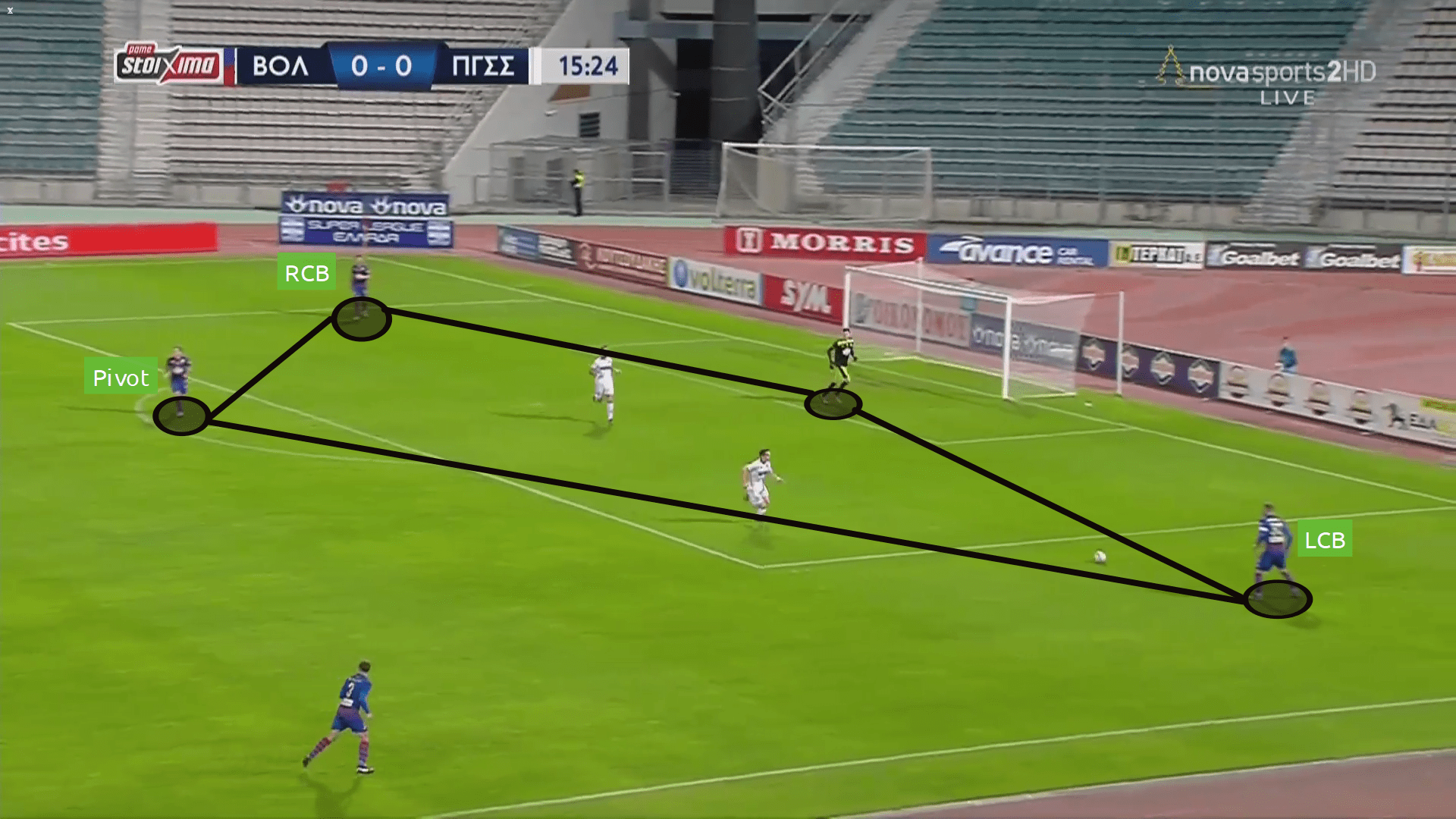
In the first phase of build-up, the two centre-backs split wide, full-backs are pushed higher and one of the midfielders drop deep and acts as the pivot and along with goalkeeper forms a diamond. The above image does not draw a complete picture. The two forward players of the opposition were marking the two centre-backs, the pivot was marked by another opposition player. So, Volos used the help of the goalkeeper to create a 4 v 3 overload and used him extensively in the first phase of build-up.
You might argue how does it help Volos in advancing the ball. When the opposition tries to press them with the same number of players, the advanced players of Volos drops deep to again create an overload and thus opens up several passing lanes.
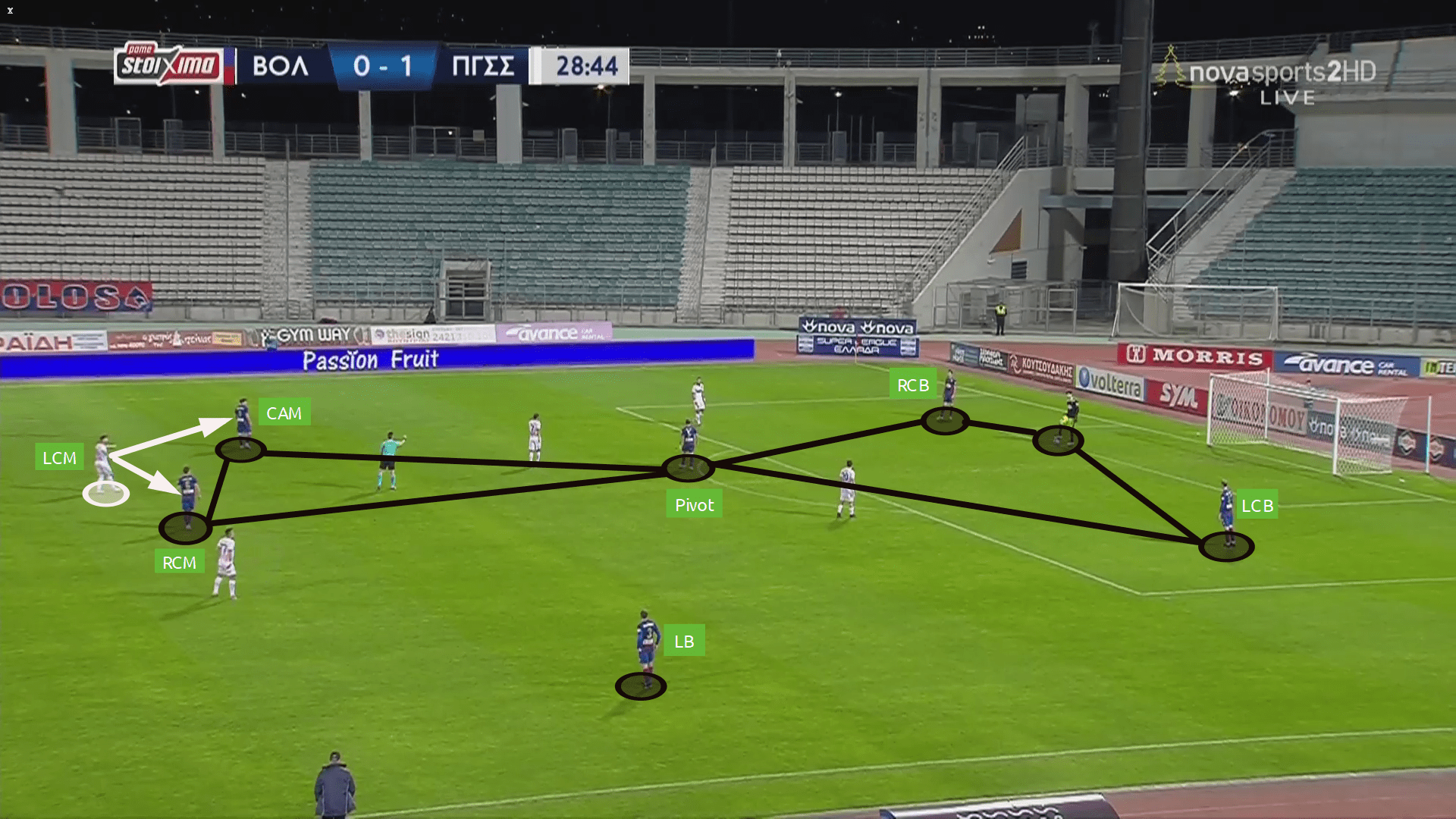
As you can see in the above image, the CAM drops deep to form a triangle with the midfielders and open up another passing lane, thus creating an overall overload and numerical superiority of 7 v 5 (including the goalkeeper) and numerical superiority on Giannis Oikonomidis (LCM). The numerical superiority on the LCM also forces the Panionios right-winger to tuck in and thus leaves a lot of space for Franco Ferrari (LB). The Volos goalkeeper being presented with a few passing options, chose a safe passing option in Ferrari.
The advantage of playing with 4-2-3-1 is that the role of attacking midfielder becomes very flexible and he can be used extensively in creating overloads in certain areas. For Volos, in the first phase of build-up, the attacking midfielder is both used to create an overload as well as used as a second man or a bounce pass to help the 3rd man in the build-up. The attacking midfielder generally drops to the vertical half his team is trying to build the play from and forms a triangle with the midfielders. This triangle helps a lot in the build-up.
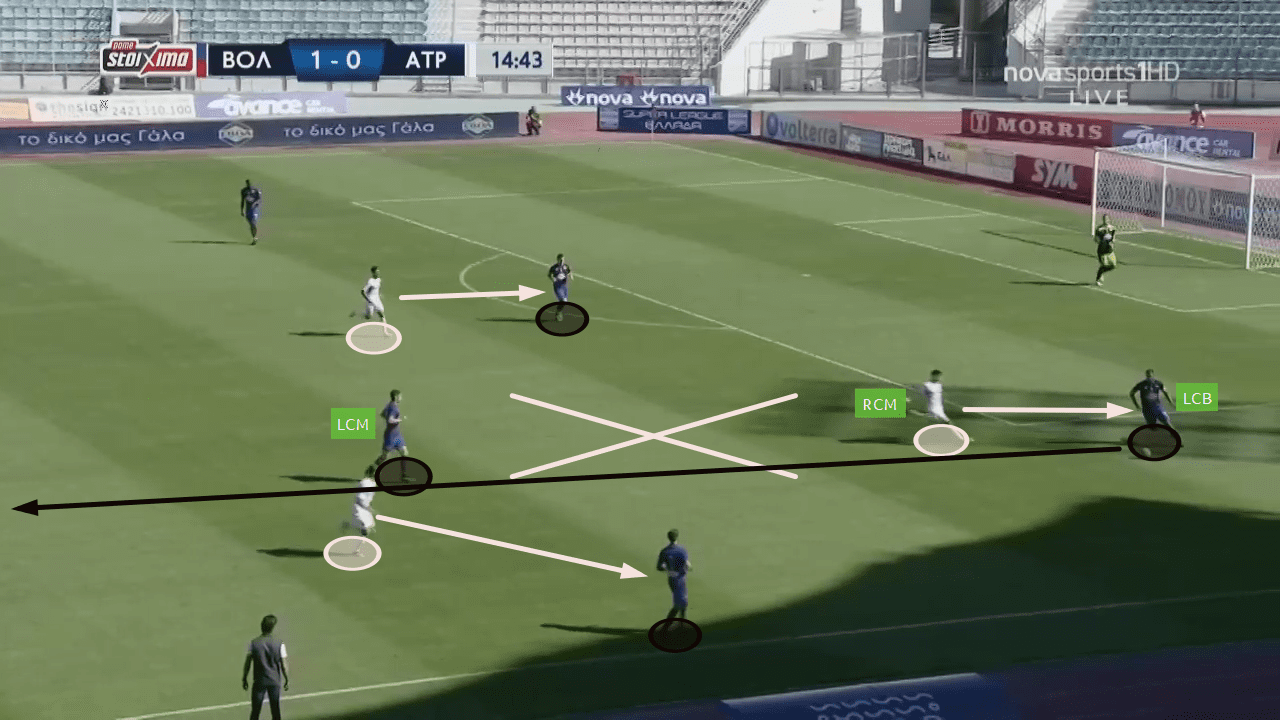
In the image above, Atromitos (opposition team) pressed Volos with a numerical disadvantage. However, the RCM of Atromitos pressed Stergios Dimopoulos (LCB) as well as cover shadowed Konstantinos Balogiannis (LCM). The LCB had an option to play a safe ball back to the goalkeeper but the principle of Ferrando indulges in vertical passing. So, Dimopoulos (LCB) played a lobbed ball to the dropping CAM (not in the frame).
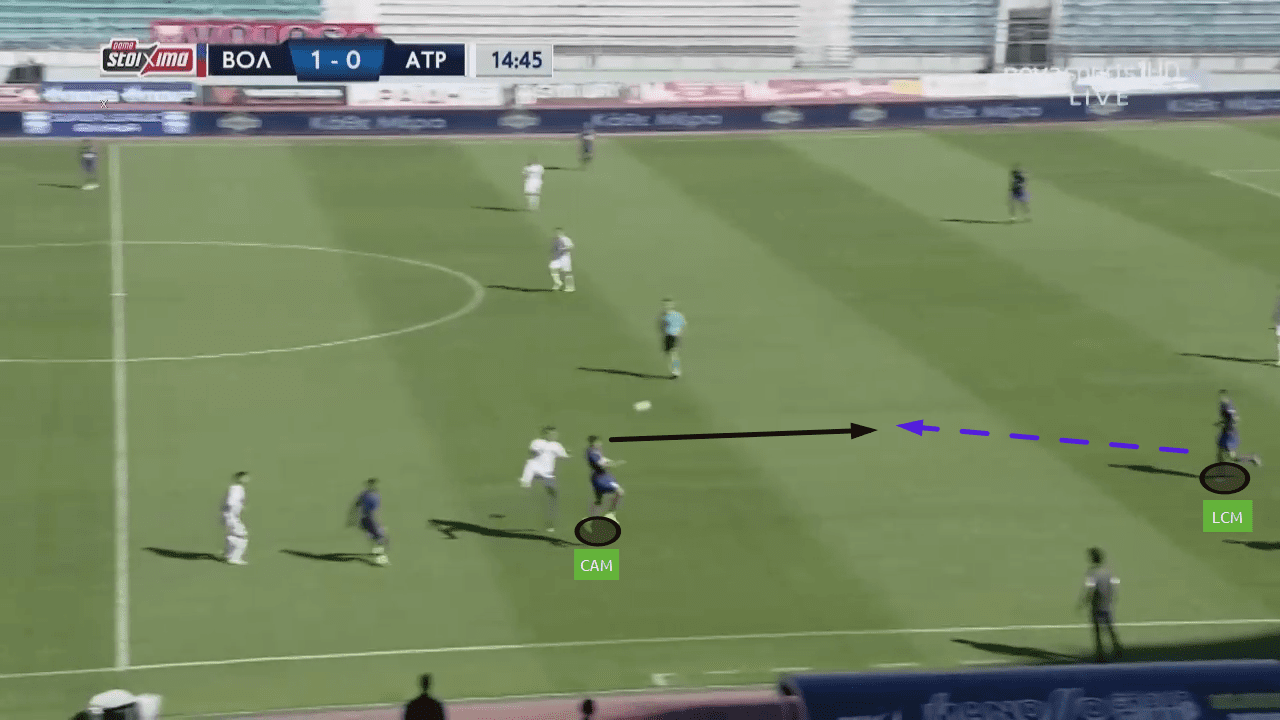
Juan Muñiz (CAM) acted as the bounce pass for Volos build-up in this instance. As Dimopoulos (LCB) had no option to pass the ball directly to Balogiannis (LCM)), he used the help of Muñiz (CAM) to pass the ball to the LCM’s (who is acting as the 3rd man) direction. The lobbed ball was headed back to Balogiannis by Muñiz and Volos successfully bypassed Atromitos’ first line of press.
Juan Ferrando looks to stress in overloading the first phase of build-up to such an extent that often the wingers drops to an inverted position to open up a passing lane for his defenders if the opposition matches them in numbers.
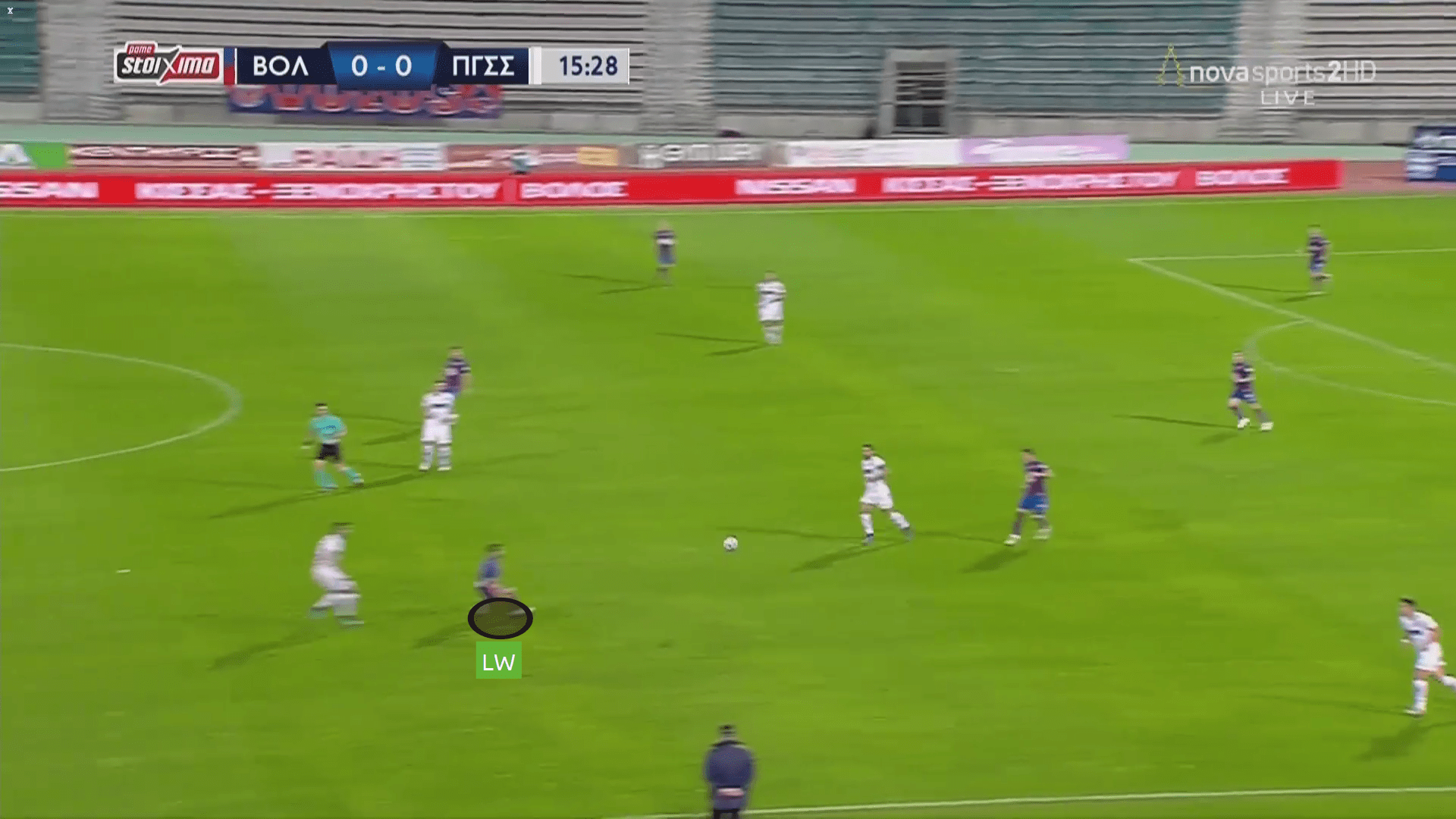
Here, the left-winger drops deep and becomes the second man in this phase of build-up and activates the 3rd man principle by passing the ball to a midfielder (3rd man).
However, the overloading of the first phase of build-up underloads the other areas and sometimes it leads to a conundrum for Ferrando when the dropped attacking player does not react quickly.
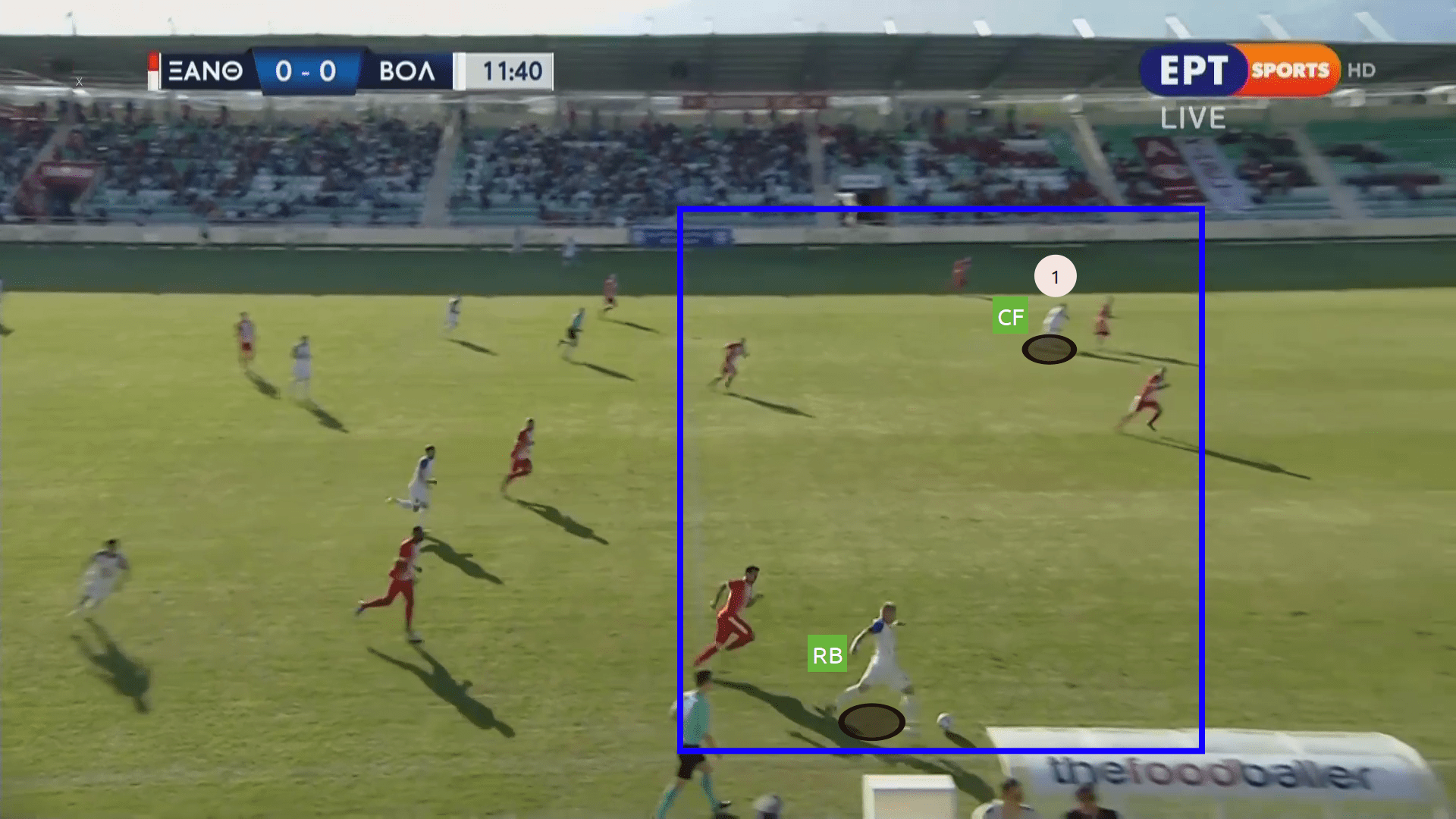
The above image is a classic example of the Volos’ conundrum in the build-up. Here, the right-back is through to advance with the ball but he has no support from his teammates. The only advanced player is the striker, and the wingers and the attacking midfielder could not react back quickly and provide support. With negligible support, the right-back crossed the ball to the striker, only to be intercepted by the opposition.
Creating numerical superiority
The above section showed Ferrando’s principle of overload, vertical passing and 3rd man principle. This section will delve upon more of vertical passing to penetrate the defensive lines, use of half spaces and more of overload in the form of numerical superiority on a certain player.
When Volos bypassed opposition’s first line of press, the pivot would form a three-man backline with the centre-backs and the other midfielder would normally position himself in between the first and second defensive lines of the opposition.
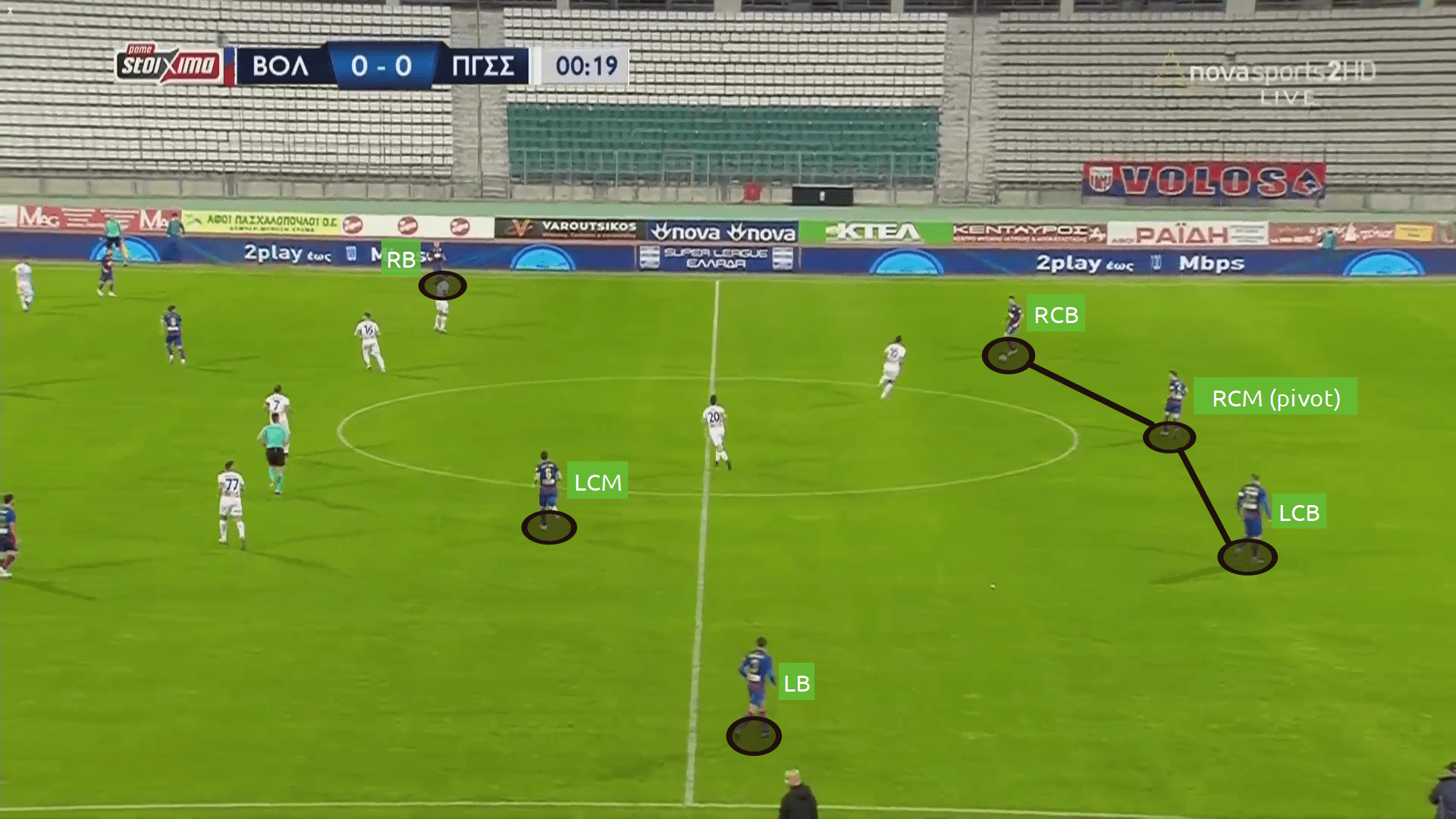
Again, with the positioning of the pivot, Volos overloads opposition’s first line of press and the other midfielder sits in between the lines.
The intention of overloading is to free up a player in carrying the ball forward. With Volos, overloading the opposition’s first line of press, the wide centre-backs now have a license to carry the ball forward to look for a better and advanced passing option.
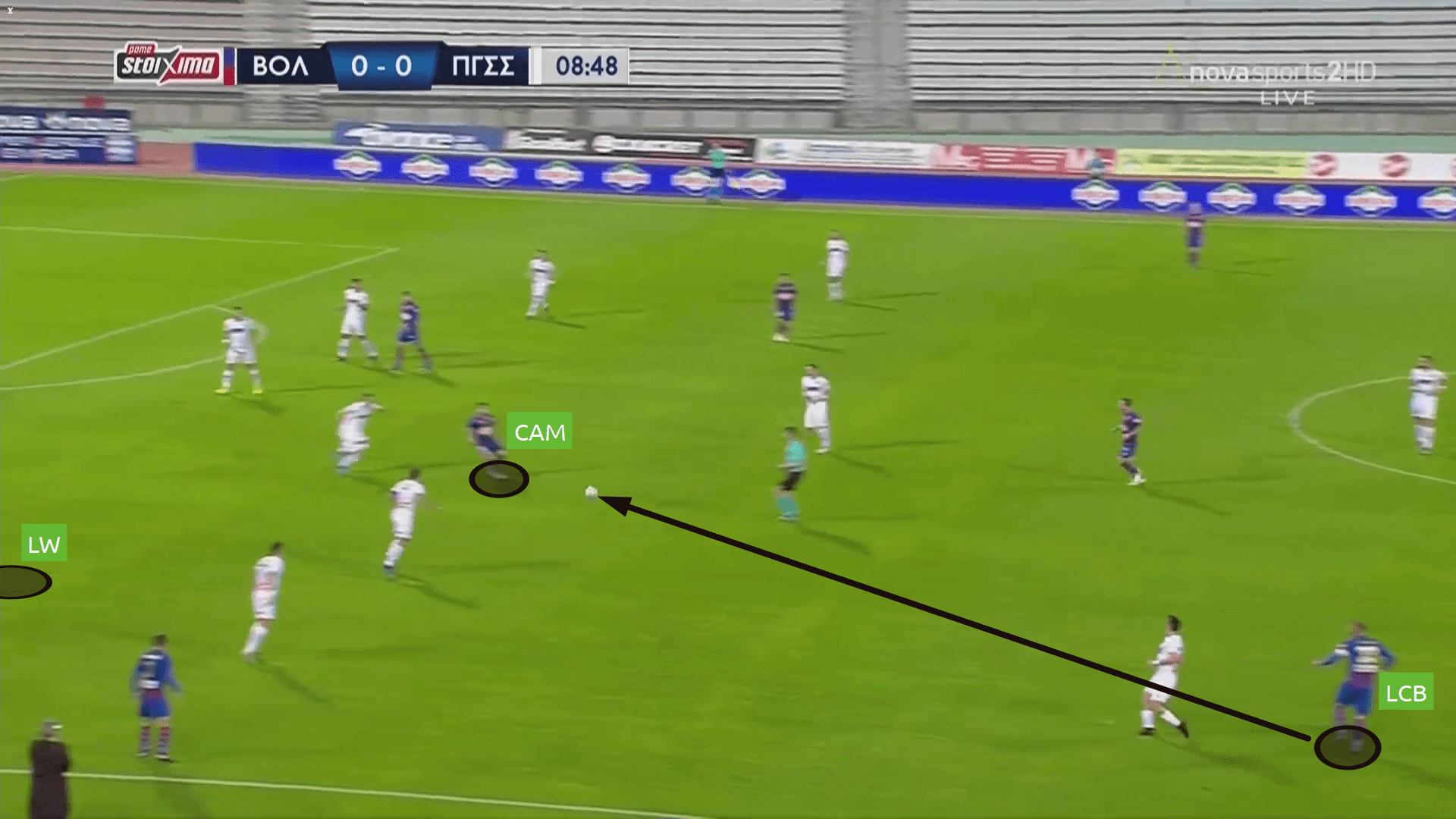
The above image vividly depicts the penetrative and vertical passing Ferrando instructs his players to perform. By overloading, Dimopoulos (LCB) now has the time to carry the ball forward and look for a better passing option before being pressed by an opposition player. Here, Muñiz (CAM) sits in between the lines and creates a numerical superiority on the opposition’s right-back along with the left-winger (not in the frame). Muñiz’s positioning drags away the opposition right-back from his position but the LCB’s brilliant pass was wasted as Muñiz could not flick the ball to the left-winger.
This image also portrays how the wingers invert to the half-space and the width is maintained by the full-back. The positioning of the Volos players almost alters the formation to 3-4-3 in the opposition half.
The numerical superiority on a certain player isn’t just observed in the defensive third or the final third. Occasionally, to advance to the final third, the attacking midfielder drops from between the lines to the second defensive line of the opposition to create a numerical superiority and the swift movement of the attacking midfielder takes the opposition by surprise.
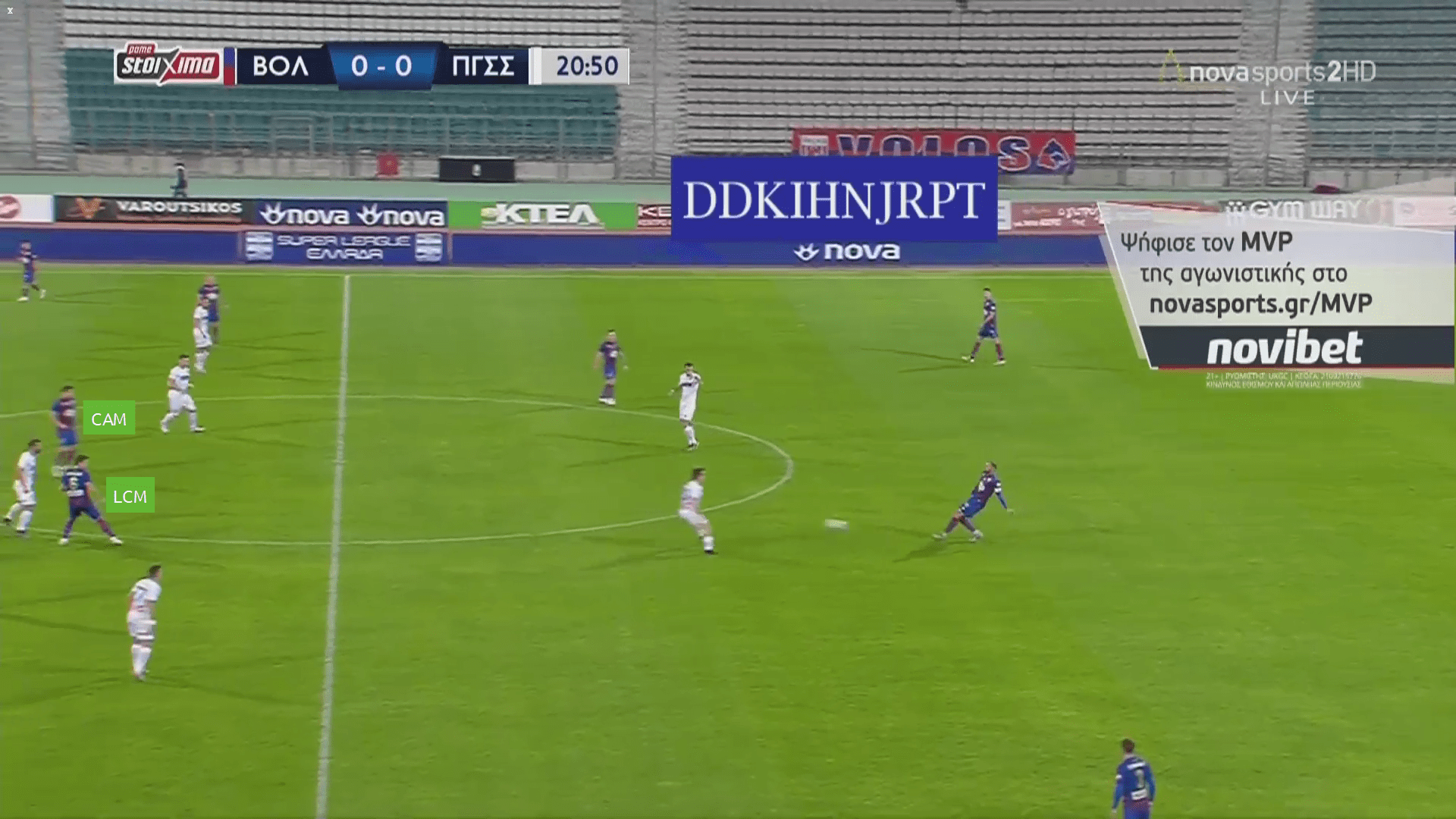
The image above portrays a beautiful picture of how creating a decisional crisis through numerical superiority helps in the build-up. The backline consists of three players. The LCM (#6) now moves from between the first and second line of defence to the second line of defence and the attacking midfielder, Muñiz, drops from the second and last line of defence to the second line of defence and causes a numerical superiority on the opposition RCM. It creates a decisional crisis on the opposition RCM whether to mark the Volos LCM or the dropping CAM. The pivot in the backline passed the ball to the CAM who played a first time ball to the striker.
One thing is to be noted is that the pivot does not always drop to the backline. If he is able to provide a passing option to the centre-backs initially, he would position himself in front of the centre-backs. If not, then he drops to form a three-man backline or sometimes he would initially drop to form a three-man backline to create an overload and thus giving the time and space for the centre-backs to carry the ball forward to have better passing angles. The basic idea is to progress the ball to an advanced area of the field.
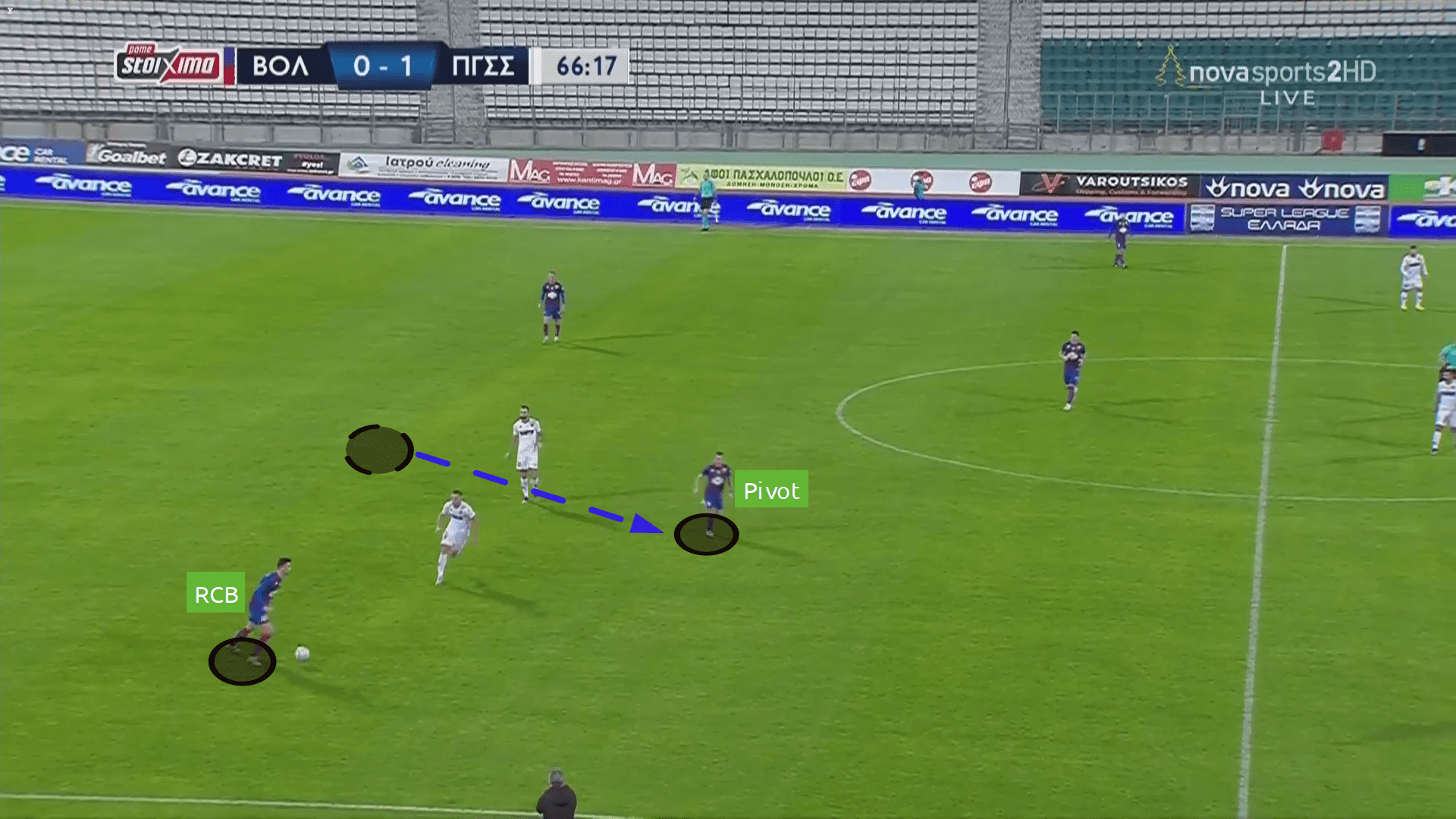
Here, the pivot initially formed a three-man backline and due to the opposition’s press, they weren’t able to circulate the ball fluidly. So, the pivot moved up the line and provided a better passing option to the RCB.
Rotation to create space and a ‘free man’
Rotation has become a common element in modern football, from the first phase of build-up to the last, rotation is seen in abundance. Sometimes rotation is done to overload a certain space/area, sometimes it’s done in order to overload a space to isolate another. Sometimes it is just a countermovement to create a ‘free man’. Countermovement as in, all the spaces are covered as it was initially but the personnel occupying a space changes to confuse the opposition. The countermovement requires a lot of coordination. One player acts to the trigger movement of the other and it naturally comes in when you get to play together and build coordination along with the gaffer’s input.
The countermovement
Overload is tackled by a lot of teams by using cover shadows in their press and it really makes it difficult for the team in possession. To tackle this, generally, the movements of the players are key to open up passing lanes and apart from the individual movements, the countermovement also becomes a key factor in the build-up.
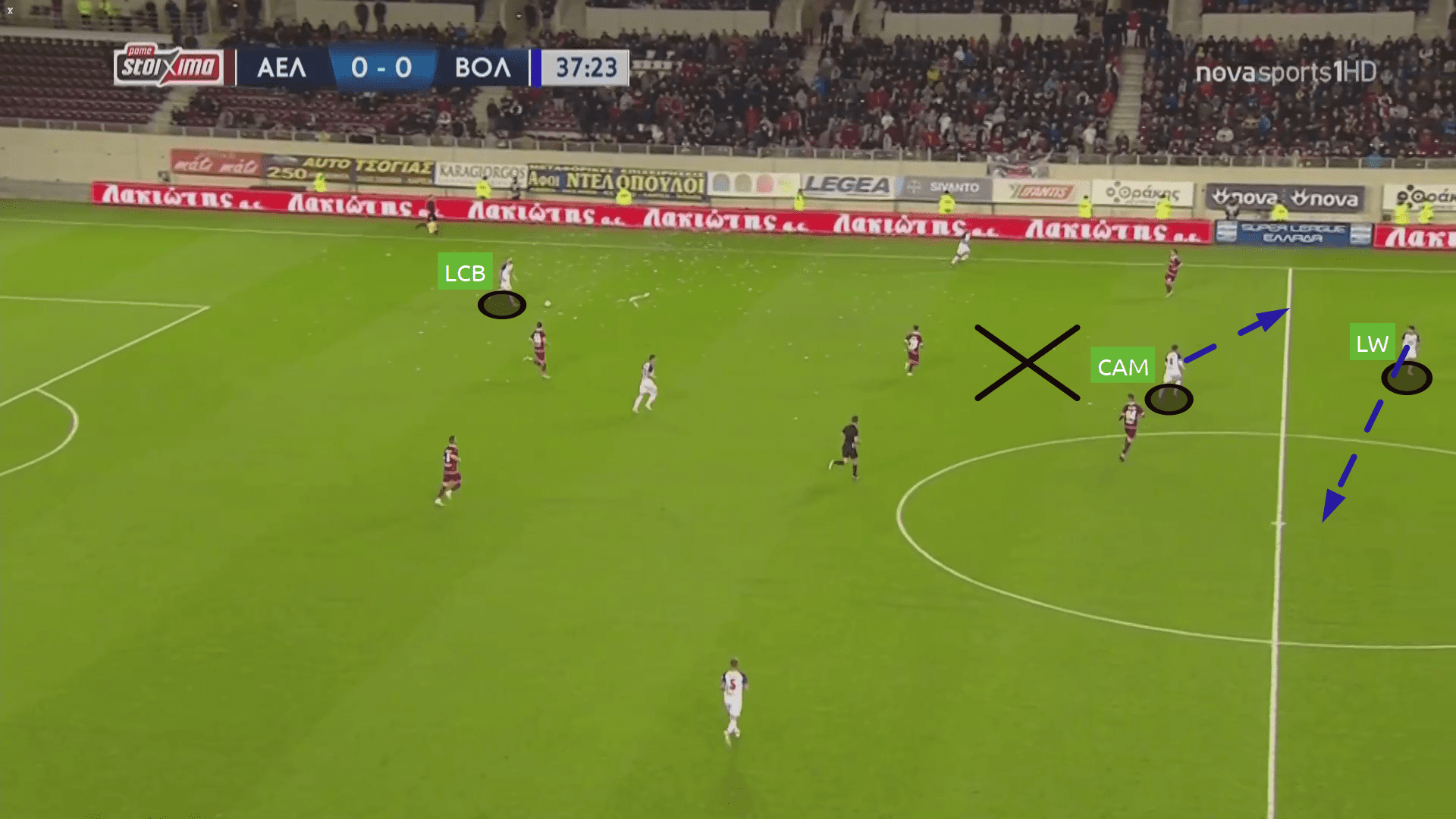
The LCB carrying the ball forward, wasn’t able to find an unhindered passing lane. So, the left-winger and the CAM decided to rotate through counter movement, thus exchanging their spaces, to shake off the cover shadow.
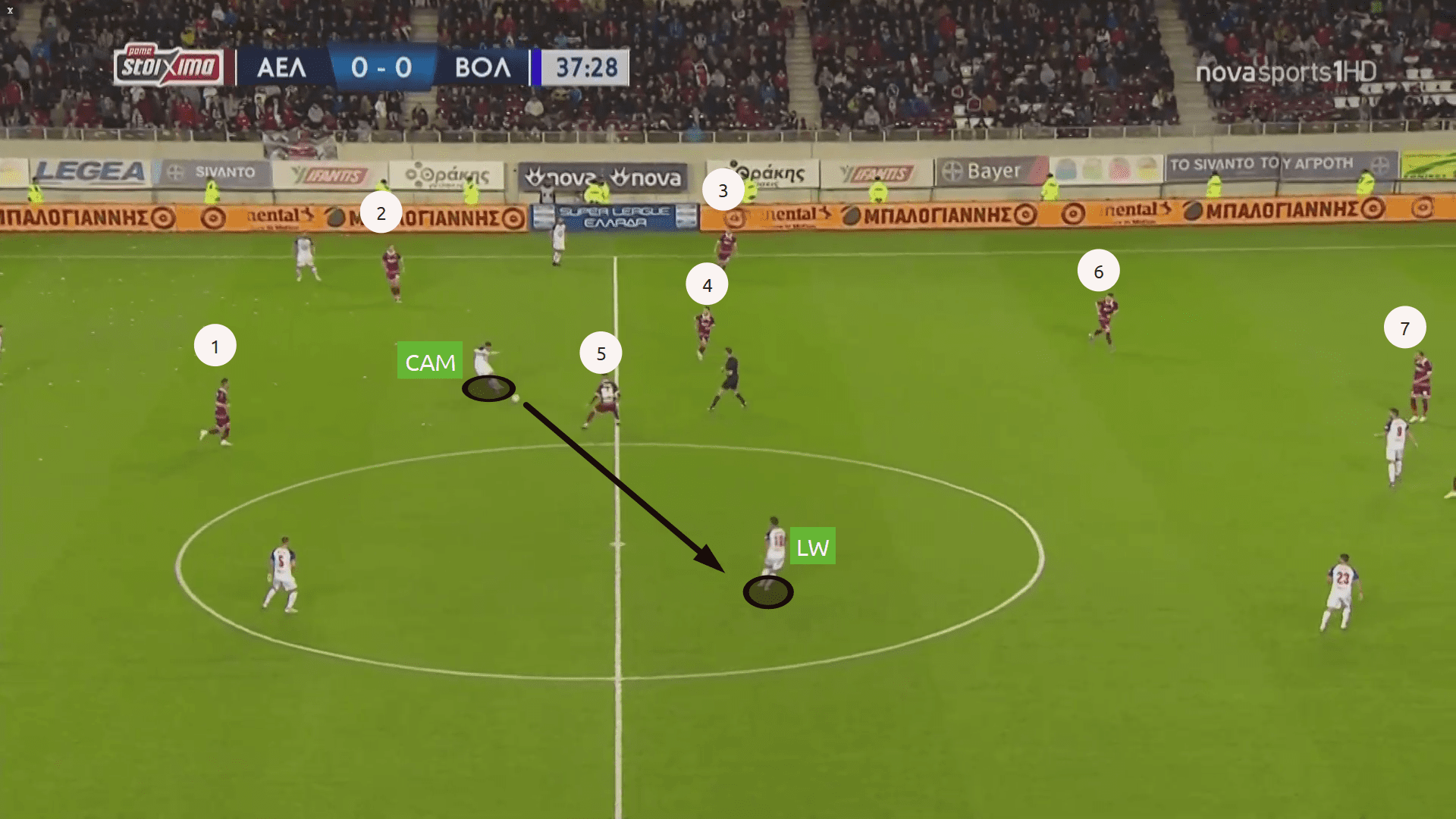
The LCB finds a pass in the form of the attacking midfielder and the rotation causes a huge space for the left-winger on the right vertical half (from Volos’ perspective) as seven Larissa players are on the left vertical half (from Volos’ perspective). The attacking midfielder finds a pass to the left-winger and Volos scores a goal from this situation.
These sort of countermovements by the Volos players were seen quite frequently.
Again in the image below, we can see a countermovement between the right-back and the right-winger to create space for themselves as well as the dropping striker.
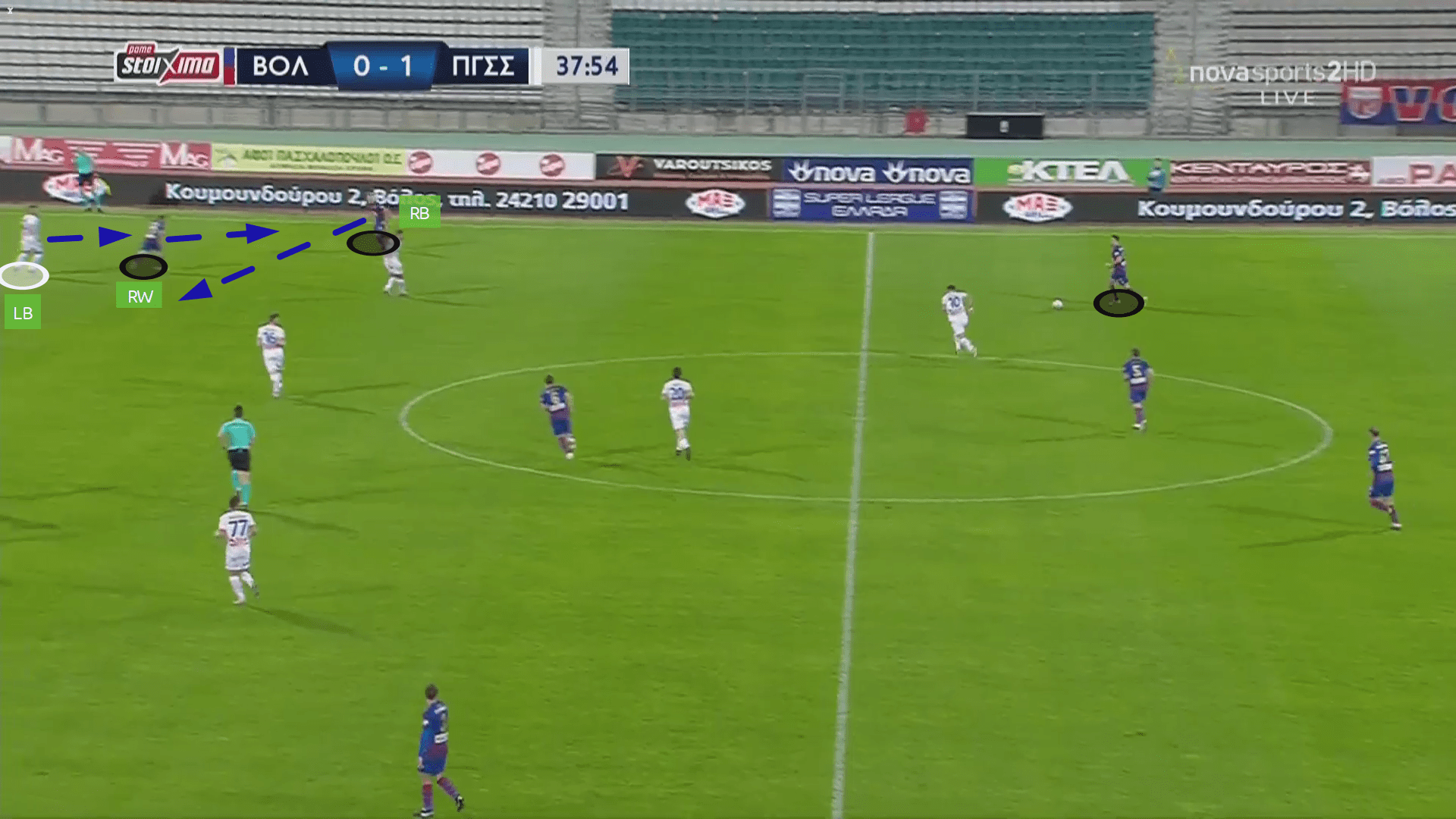
This countermovement drags away the opposition LB towards the flank a bit due to the LW’s movement thus creating space for the dropping striker in the half space which was vacated by the right-winger.
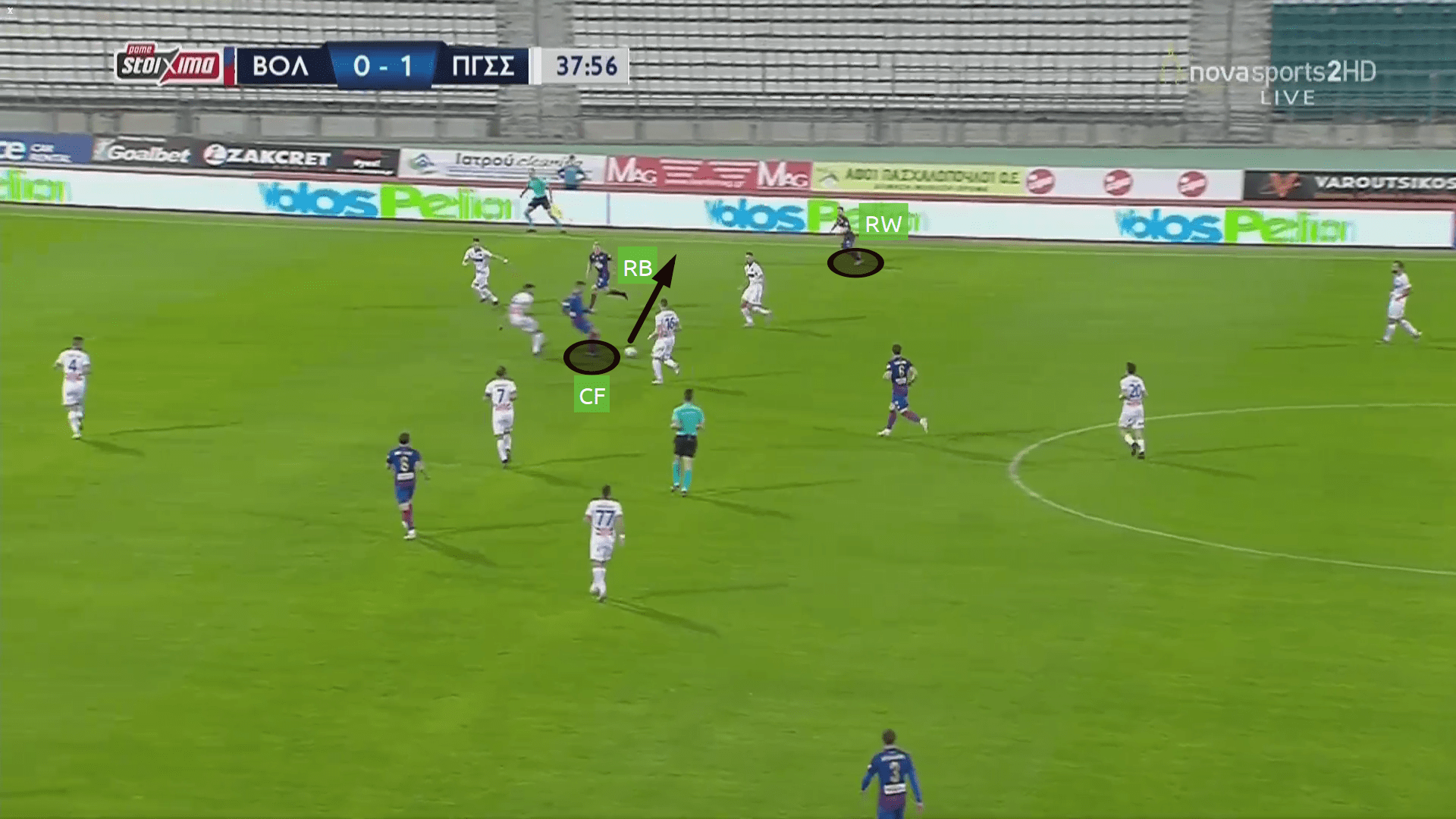
The RCB passed the ball to the striker who played a first time ball to the right-winger, who becomes the 3rd man as well as the ‘free man’. ‘Free man’ can be defined as the 3rd man who has space, time and ability to progress the ball beyond the opposition’s line of pressure towards the opponent’s goal. As you can see, the right-winger is in a lot of space and has the time to create a dangerous situation for his team.
The triangles and diamond
Juan Ferrando uses a lot of triangles and diamond in the opposition half. Rotation through these shapes helps a lot in creating a free man and thus progressing the ball to a more advanced area. These shapes are especially formed on the flanks and half spaces majorly by the attacking midfielder, winger and a full-back in case of a triangle and joined by a midfielder in case of a diamond.
These shapes are possible because Ferrando does not like to have more than one player on a flank in the opposition half. That’s the reason you would see the wingers inverting to the half spaces and the full-backs providing width. When the wingers provide width, the full-backs invert. You won’t generally find two players in the same line on the flanks. Sometimes you might notice, two players in a line which is just for a second or so due to rotation.
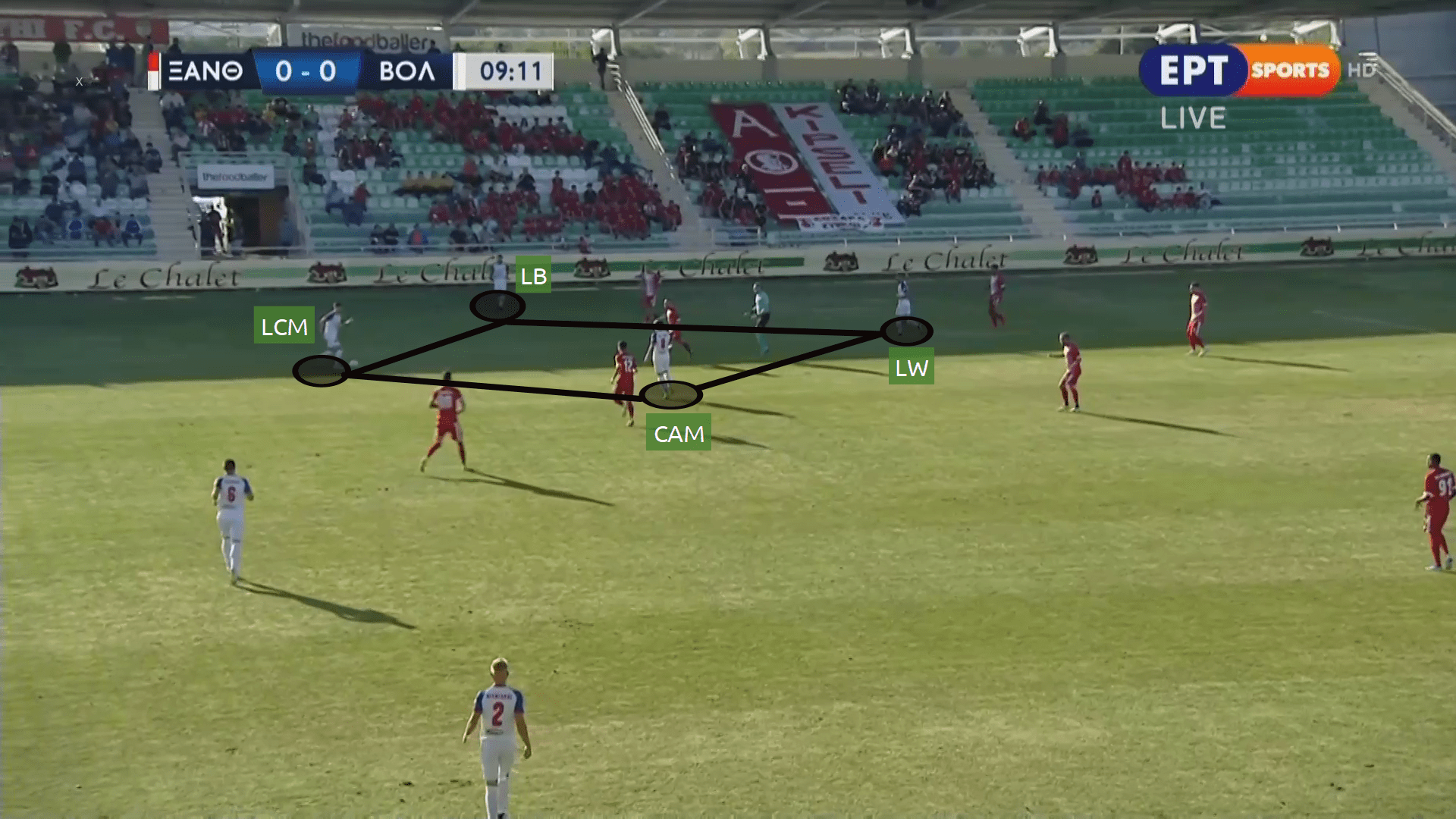
Here, the LCM is the ball carrier and the LW in the half space is the top of the diamond joined by the CAM and LB to form a diamond. The LCM has a lot of space and time on the ball but he isn’t a free man as he can’t create a dangerous situation as he has too many obstacles in between.
If in a diamond few principles are integrated, it helps massively in the build-up. In this situation, Volos implements pass and move and 3rd man principle to create a free man in the form of the same LCM who was the ball carrier initially.
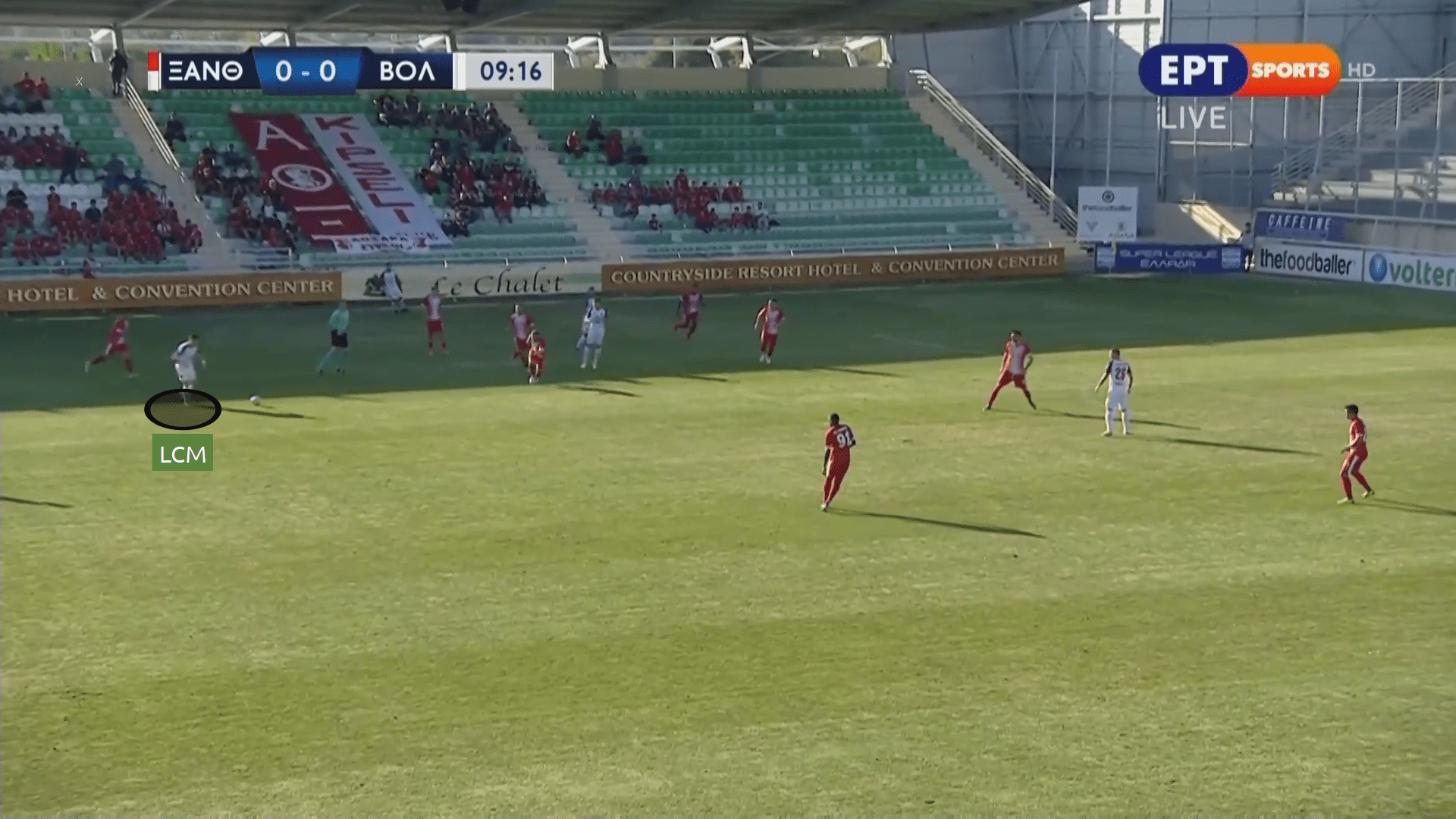
The above image shows the LCM in a lot of free space and time to influence the game. Using these principles along with rotation, the left-winger and the attacking midfielder dragged away two opposition players from the LCM’s path. Wish I could show the entire sequence through a video, but sadly I can’t. It was a brilliant bit of football by Ferrando’s men.
Overload to isolate
It has become a common phenomenon of a possession-based side to overload an area to isolate another. This is done by several teams for several reasons. Either to gain qualitative superiority or to just plot the next move to score against the opposition.
Juan Ferrando uses a lot of crosses to directly influence the game and that’s the reason he tries to isolate his winger or the full-back to have time and space to produce better crosses.
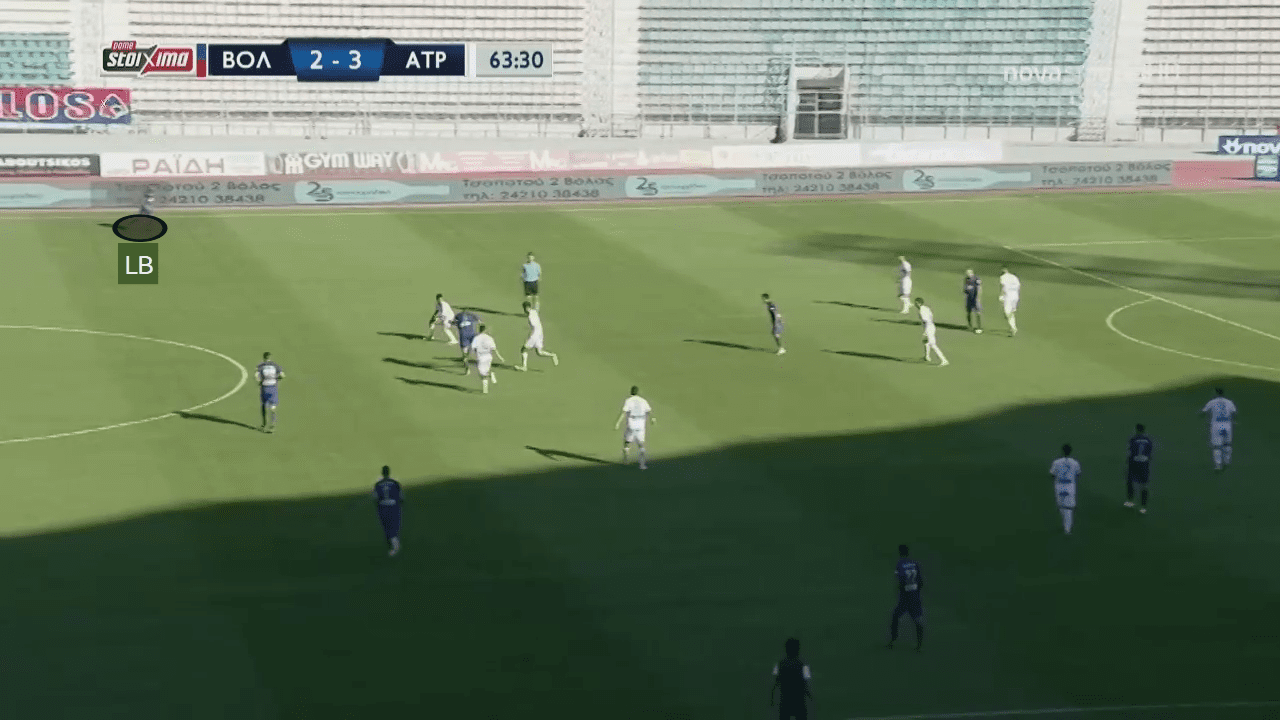
Here, it can be seen that almost all the players are on the right vertical half (from Volos’ perspective) and the left-back is kept completely isolated from the action initially. Volos succeeded in playing the ball to the left-back but his poor cross let the team down.
Ferrando uses all these principles to progress the ball to the final third in order to play his final move which is mostly crosses (obviously crosses are not his only move).
The final move
The majority of the build-up end on the flanks for the player to cross the ball into the 18-yard-box and all these principles Ferrando implements is to create space for the final delivery whether if it’s a cross or a through ball or a simple pass.
Generally, when Volos looks to produce a cross, the 18-yard-box is swarmed with at least three players to influence the scoreline.
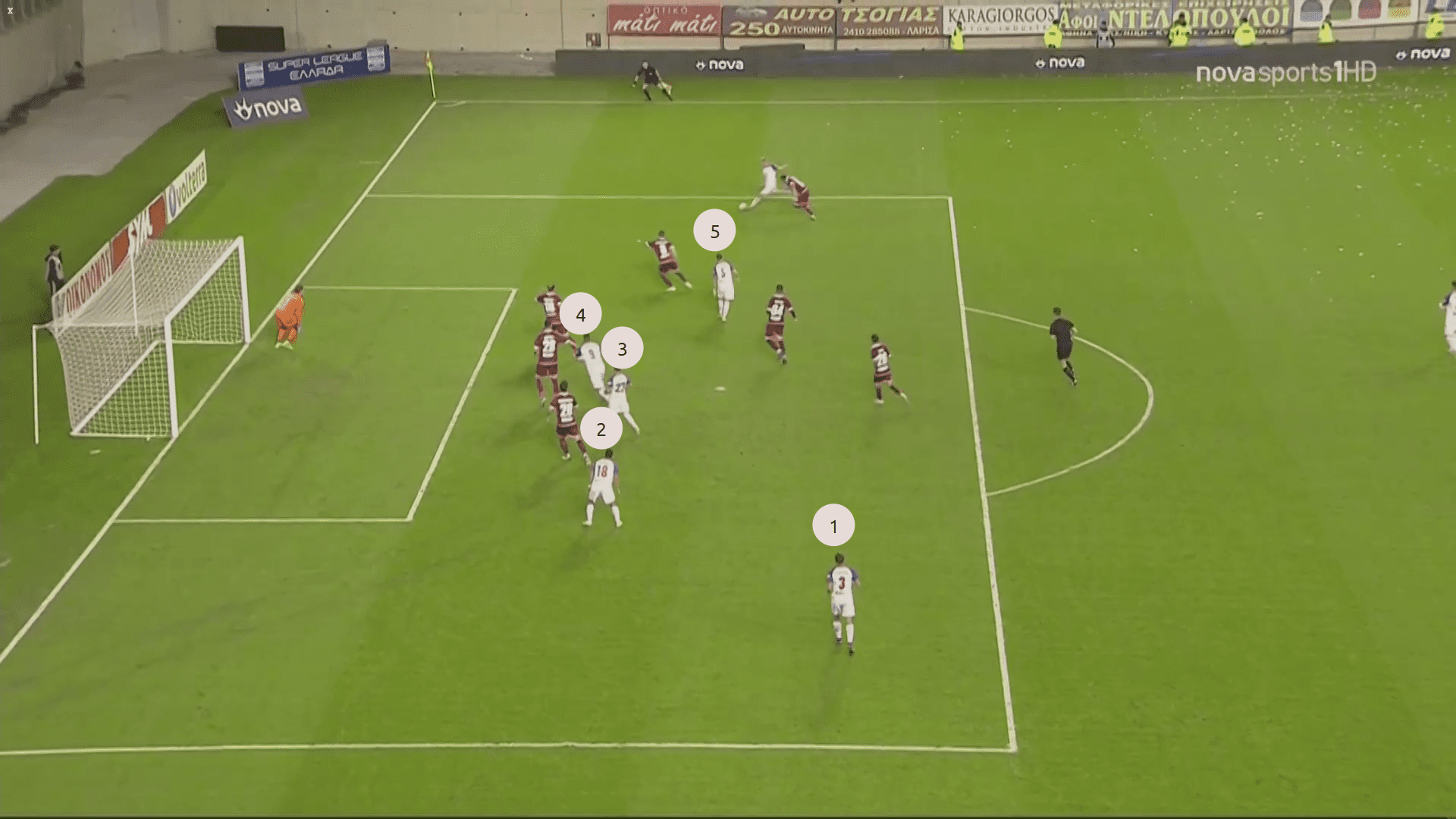
In the above image, the right-back finds himself in a little space to produce a cross into the box and as you can see, there are five Volos players inside the 18-yard-box, the left-winger, the right-winger, the striker, a midfielder and the full-back.
The crossing of Volos is slightly different from other teams. We often see Manchester City producing a lot of crosses and cutbacks and the other teams aiming for players just in front of the goal. However, Volos along with all those options, often tries to play the ball to the far post. The player at the far post generally remains at the blindside of the full-back and thus can directly shoot from a tight angle or just lay a pass for his teammate in a better position, thus confusing the opposition.
In the image below, a situation is shown where the principles led to a goal for Volos.
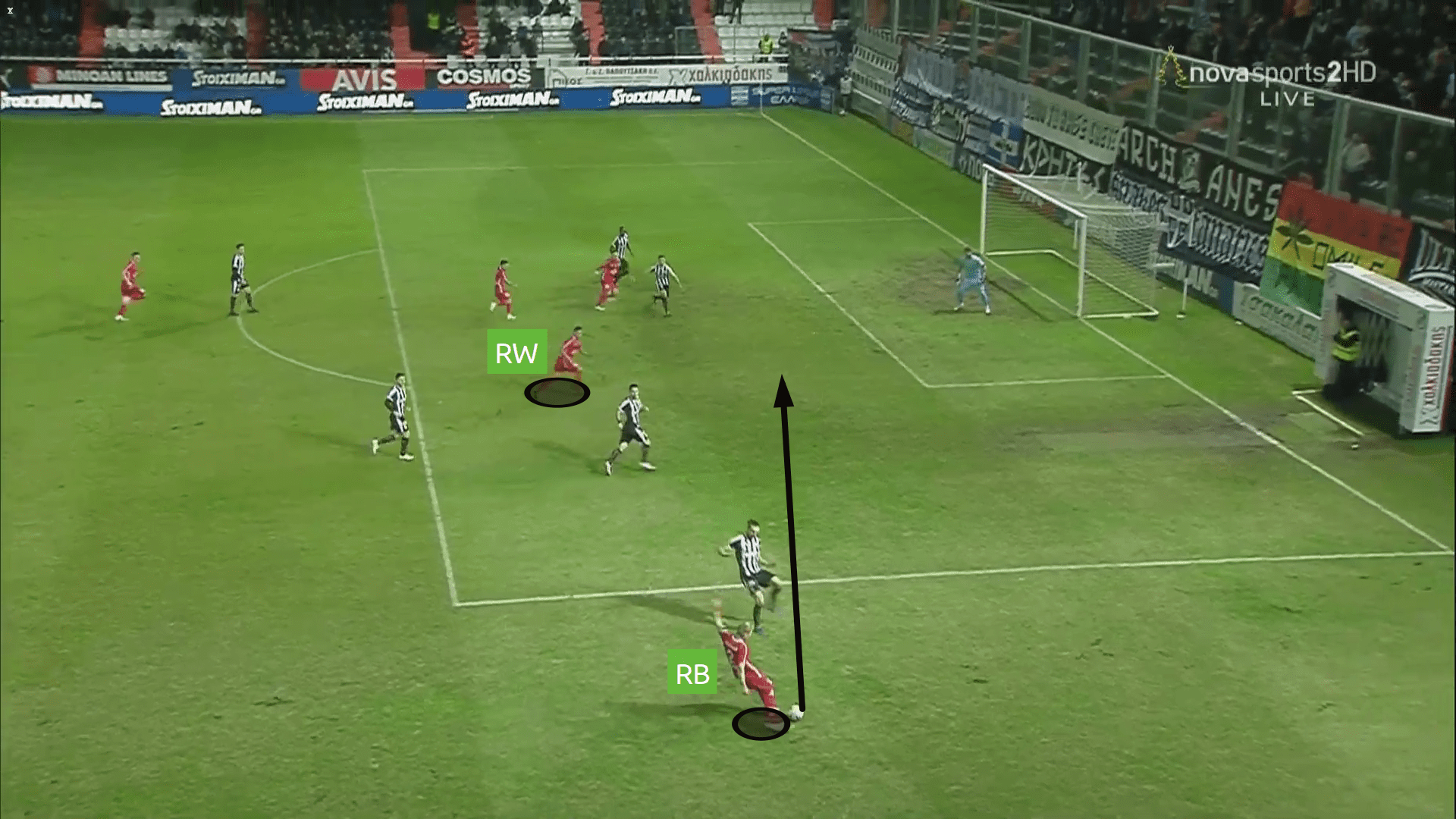
The left-winger combined with the right-winger who passed it to the right-back and both the wingers made a run inside the box to create an overload on both the opposition centre-backs. This resulted in the opener for Volos in this fixture against OFI.
FC Goa would be glad to rope in a manager who is not much different from the previous manager who took Indian football by storm. FC Goa won’t see as many goals as they scored under Sergio Lobera but the brand of football Juan Ferrando will bring in to the Gaurs would be exhilarating for sure.
Defensive transition
There are various possession-based side which concedes a lot of goals in counter attacks owing to their poor rest defence. Rest defence is one of the vital aspects of football which can be defined as the defensive structure a team holds when in possession. A proper rest defence helps in an effective and efficient counter press in order to prevent a counter attack as well as regain possession and sustain attacks.
As you have seen, Volos pushes a lot of bodies to the 18-yard-box or to an advanced area which does not help in building a proper rest defence. It might give an indication that Juan Ferrando’s side concedes a lot of goals from counter attacks. However, that’s not the case.
Due to Volos having a good few numbers of bodies in the 18-yard-box or in the final third, the first reaction of Volos when they lose the ball in such areas is always to get behind the engagement line as quickly as possible without putting much pressure on the opposition ball carrier. The engagement line is the line where the most advanced player of a team can engage with the opposition in tandem with his teammates.

The image above clearly depicts the defensive transition Volos indulges in. The Volos based club lost the ball in the final third with five Volos player behind the opposition’s ball carrier and the primary reaction of the Volos players were to get behind the engagement line as quickly as possible without putting much pressure on the ball.
The counterpressing intensity increases as Volos loses the ball closer to their goal. We have seen how Juan Ferrando loves to overload in each phase of their build-up especially in the initial phases. So, the rest defence is more structured and have players closer to the ball if and when they lose it, which enables Volos players in the vicinity of the ball to press rather than going back to the engagement line.

Here, as you can see one player presses aggressively to win back the ball and other players in the vicinity tries to block the passing lanes.
Out of possession tactics
Out of possession, Volos under Juan Ferrando mainly pressed the opposition high with 4-4-2 (CAM along with CF becomes the first line of press) pendulum press and against a three-man defence they opted for a 4-2-3-1 high press. However, the opposition built-up, the philosophy Juan Ferrando believes in is man-oriented zonal marking, out of possession. In easy terms, it is a mix between man-marking and zonal marking. Zonal marking refers to each players covering a certain area. In a man-oriented zonal marking, the reference point is the opponent. So, each player covers a certain space as well as moves relative to the opponent in his zone. The other aspect of man-oriented zonal marking is that the players do not press the opposition players aggressively rather use a lot of cover shadow and mild pressing to cut off various passing lanes of the opponent.
Pendulum press is executed by the front two, where the forward closest to the ball carrier (centre-back) presses him from in to out thus preventing a passing lane to the pivot and the other forward stays close to the pivot in case the ball carrier (centre-back) finds a pass to him. When the ball-carrier (centre-back) plays a lateral pass to his counterpart (other centre-back), the forward marking the pivot becomes the pressing player and the other forward marks the pivot, thus acting as a pendulum.
The next block of four moves with relative to the ball. It forces the ball carrier (centre-back) to pass either laterally to his centre-back or to the flank to a full-back.

When the ball carrier passes the ball to a full-back a pressing trap is created as seen in the above image. Here, all the short passing options are blocked by the Volos players. The right-back has the option to play the ball straight to the right-winger who is closely marked by the left-back of Volos or play a long ball. The right-back opts for the former and the Volos left-back intercepts the ball.
However, all six players need to fulfil their responsibility. A mistake by any of the front six will completely disrupt the pressing trap.

This was a common mistake often committed by the Volos front two. When the ball carrier is the centre-back, the cover shadow provided by the pressing forward prevents the ball from being passed to the pivot. But when the centre-back passes the ball to the full-back, the forward is no more able to provide the cover shadow as he now has the responsibility of preventing the ball from being played back to the centre-back, which is a part of the pressing trap created by Volos. So, the responsibility of marking the pivot closely falls upon the other forward. In the image above, you can see the other forward is in no way close to the pivot and gives the right-back a free passing lane in the form of the pivot and Panathinaikos easily progresses the ball forward.
When the opposition plays with double pivot, the two strikers covers the passing lane to the double pivot. The midfielders too move up if the forwards move up to press the centre-back as a clever movement by the opposition pivots might take them away from the cover shadow of the forward.

In the 4-2-3-1 system, the same man-oriented zonal marking is followed but in this case, the forward generally stays in the central channel. The attacking midfielder closely follows the opposition pivot. The wingers position themselves in the half space in between the wide centre-backs and the wing-backs. The wingers have the responsibility of pressing the centre-backs if a centre-back decides to carry the ball forward and enters into the zone of the winger or press the full-back if the ball is passed to him.
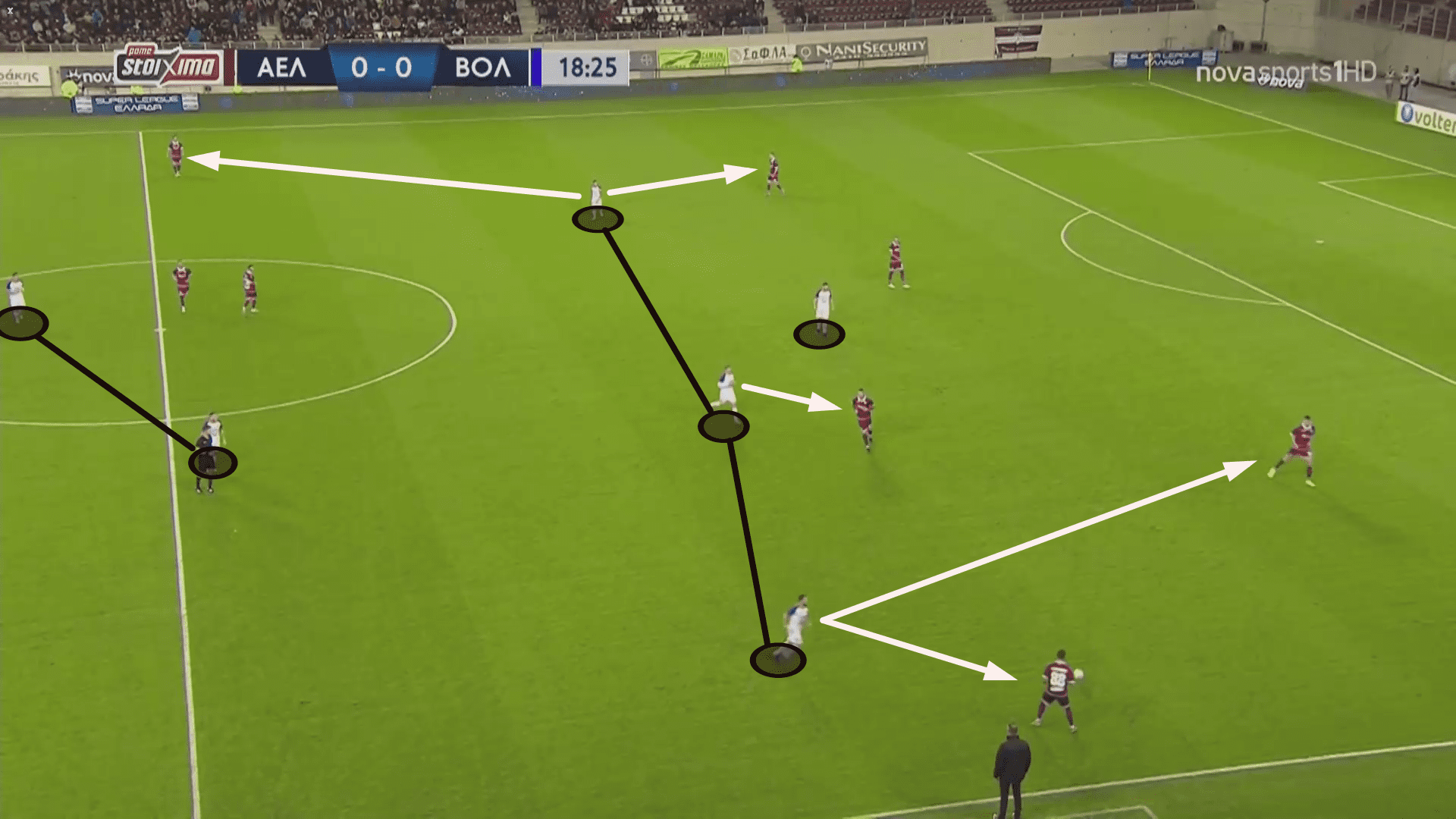
You might argue since each player covers his zone/space, an opposition player dropping deep can easily create an overload on a player. However, Volos does not let the opposition overload a certain space most of the times. This is the advantage of man-oriented zonal marking. In man-oriented zonal marking, the reference point is the opponent. So, when the opposition midfielder was in a Volos player’s space, the Volos players start marking him and when the opposition player drops deep or try to occupy another space, the Volos player who engaged with the opposition player would closely follow him wherever he goes.
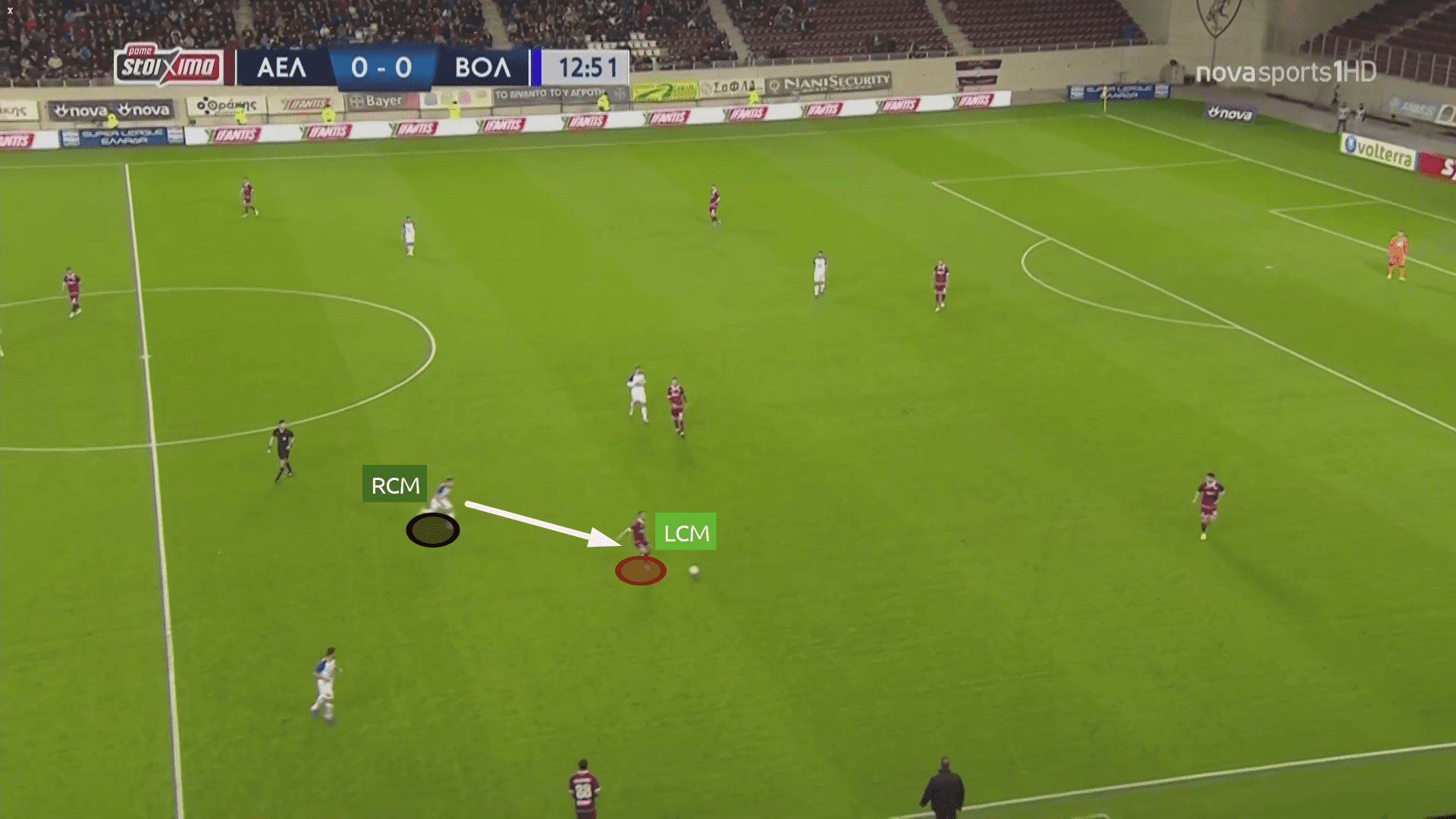
As you can see in the image above, the RCM of Volos closely follows the dropping midfielder thus preventing an overload on the right-winger.
In Volos’ own half, the Greek side defends in a compact 4-4-2 or 4-4-1-1 with the same man-oriented zonal marking.

The Volos defensive lines position themselves very tight to each other, leaving hardly any space in between the lines, especially the second and the last line of defence.
The furthest and advanced player of the opposition on the flanks is generally pressed by the ball near full-back, which leaves a gap between the ball near full-back and the centre-back. If the opposition tries to exploit the space, the centre-backs generally do not leave his place and mark the opposition, rather a midfielder or the winger follows the opposition player.
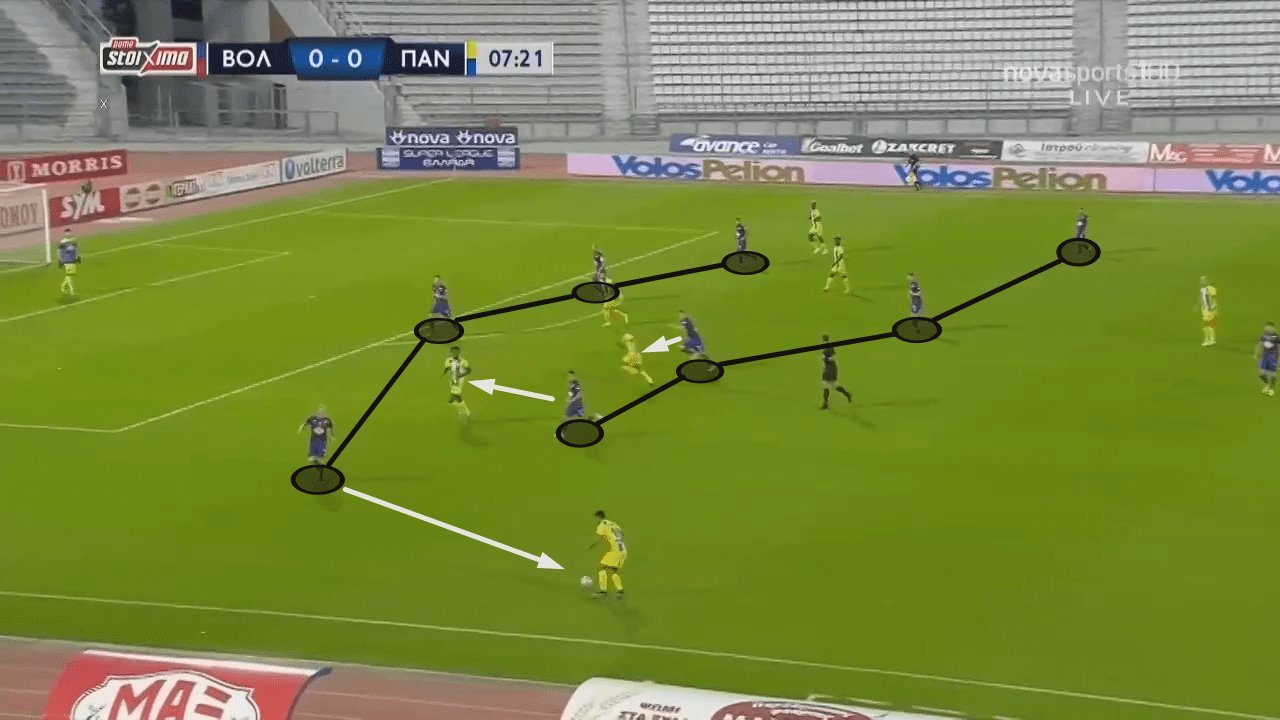
In this scenario against Panetolikos, the most advanced player on the flanks was the left-back. So, Volos right-back moves up to press him. The winger and the midfielder of the opposition try to exploit the space between the right-back and the RCB. However, due to man-oriented zonal marking Volos left-winger and RCM closely follows the opposition players in their space/zone. Thus did not let the opposition exploit the space as well as prevented an overload in the process.
Offensive transition
Volos puts a lot of stress in defensive compactness. So, it does not allow them to always hurt the opposition in transitions. As you have seen in the ‘defensive transition’ section, Juan Ferrando loves his team to get back to the engagement line as soon as his team lose the ball. It isn’t in their nature to win the ball high up the field and it rules out the fact of scoring from such position. So, how did Ferrando’s team fared in winning the ball in their own half?
The same answer prevails, however, it’s a less definitive one. Volos remained compact in a 4-4-2 or a 4-4-1-1 block, however, they kept the options of counter attack open.
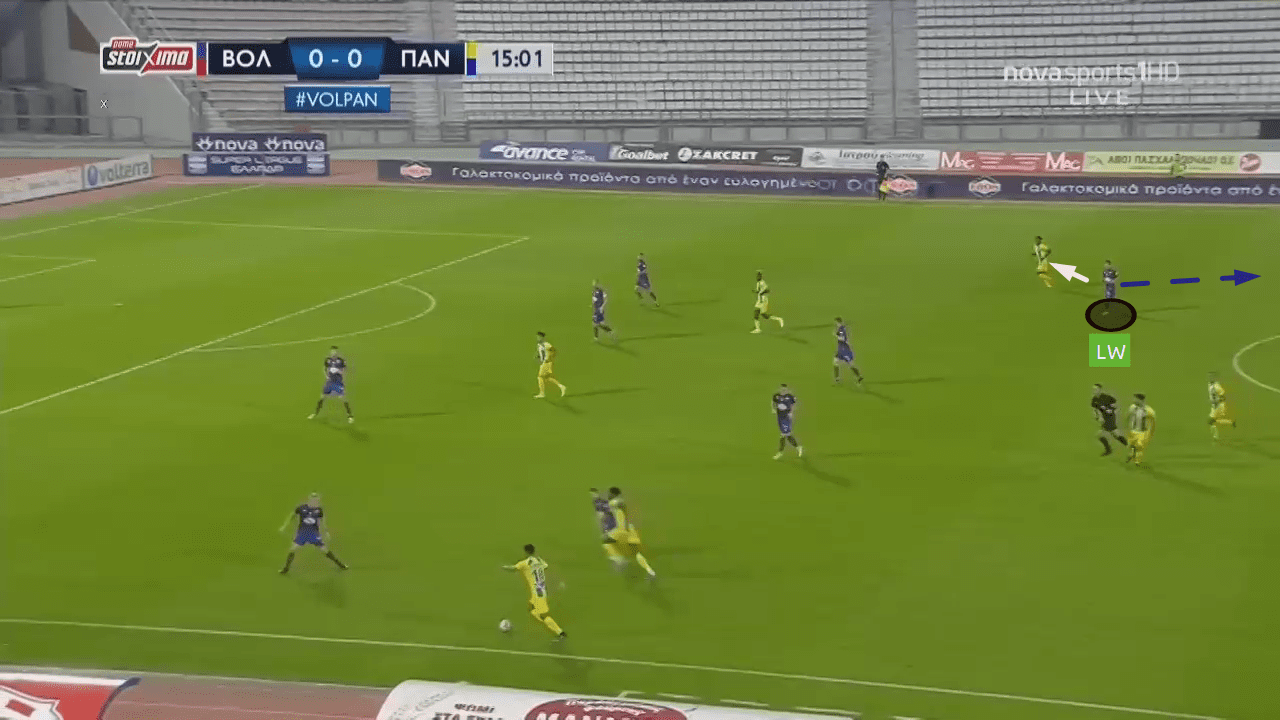
As you can see here the ball far winger (left-winger) stays a bit ahead of his immediate opposition player. By any chance, the ball near players recover the ball he can immediately switch to the ball far winger and also if the opposition tries to switch the play, he can easily recover back in time as he is not far from his immediate opposition player.
However, on rare occasions, Volos did get beat by this strategy.
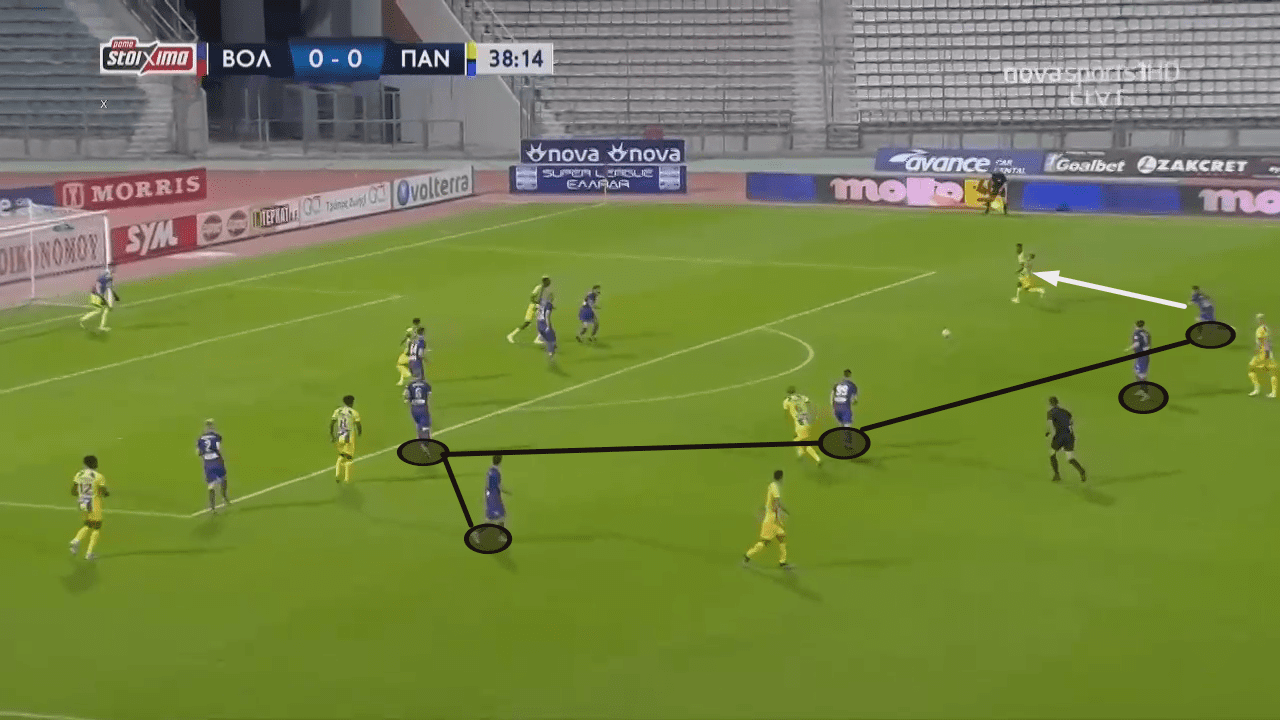
In this scenario against Panetolikos, Volos were defending in a 4-4-1-1 block, and the RCM dropped deep due to the dynamics of the game and the CAM dropped to the midfield line. However, the left-winger was a bit up as was stated above and he could not track back in time and Volos conceded from this situation.
Negativity aside, Volos did also have a few incidents of positive results to take from this approach. The primary reaction of Ferrando’s team when they recovered the ball was to always look for players on the flanks and that was provided to the team by the wingers.
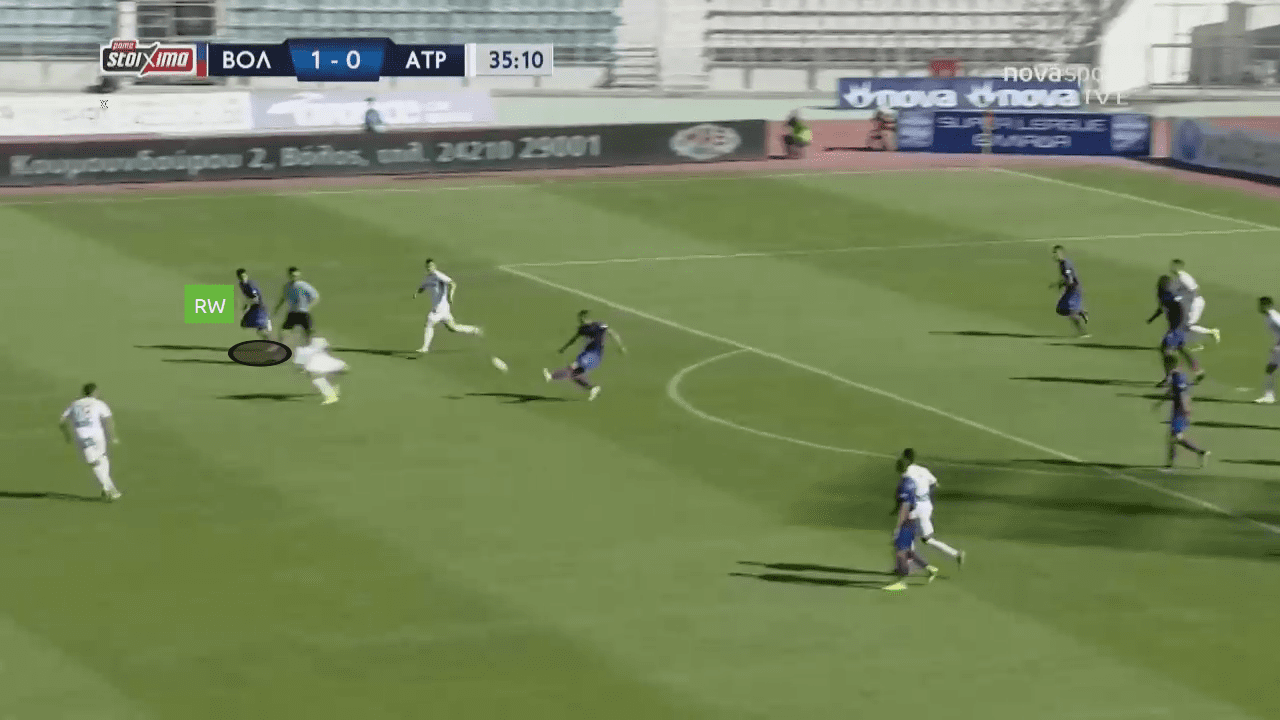
Here, as you can see Volos recovered the ball and as soon as they did, the right-winger took off. A pass by the midfielder was on point and the right-winger scored an amazing solo goal.
What can we expect from Juan Ferrando?
With the details provided to you in this analysis, we can expect, by now, you have had a rough idea in what to expect from the Spanish gaffer. However, I would like to put this into a brief summary. With Juan Ferrando, FC Goa might not find the free-flowing football all the time as they did with Sergio Lobera. However, the Gaurs would be happy to have a gaffer whose philosophy is much like their previous manager who gave them so much joy. The Gaurs would likely see a lesser number of goals at both the ends i.e. would likely score lesser as well as concede lesser number of goals than the previous year. However, with the new manager coming in, to a different environment as well as the manager coping with unavoidable circumstances and the best players leaving to a direct opponent, the fans might want to give the Spaniard a bit of time in weaving his magic.
Now, the major question many ISL fans or Goa fans would ask, how will the Gaurs line-up for the upcoming season. With the signings the gaffer made as well as the existing squad, it looks like the gaffer would carry on with his preferred 4-2-3-1 formation.
Mohammad Nawaz is expected to start in between the sticks. Seriton Fernandes and the FC Goa academy left-back, Saviour Gama is supposed to be starters as the full-backs. Iván González would be one of the centre-backs but the question that’s still unanswered who would be the one partnering the Spaniard. The reports back in May by Sagnik Kundu suggested FC Goa are looking into the profile of Roozbeh Cheshmi. If the deal goes through, it would be a dream signing. The major reason is that he has a lot of experience in grand stages. The second reason is that he is a left-footed centre-back and Juan Ferrando loves to play with a left-footed centre-back. If you have noticed in ‘creating numerical superiority’ section of this analysis, how the left-footed centre-back of Volos was used in progressing the play.
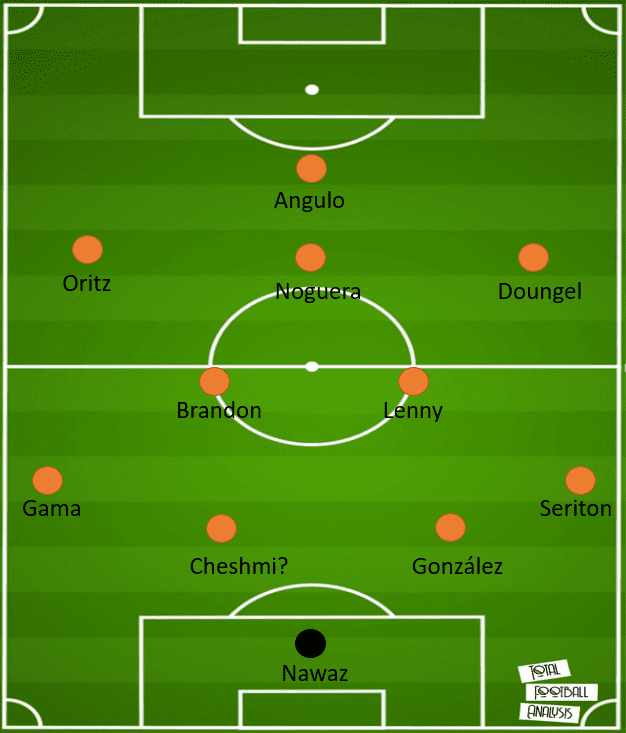
The double pivot would be Brandon Fernandes and Lenny Rodrigues. The left and the right winger would supposedly be Jorge Oritz and Seminlen Doungel. However, it depends completely upon the performances of the players. If Redeem Tlang or Makan Chote impresses the gaffer during the pre-season, they might get a look in too. The fight for the attacking midfielder would be between Alberto Noguera and Edu Bedia. The gaffer is known to be flexible with his attacking players. In Volos, the wingers occasionally started as the attacking midfielder or the attacking midfielder would drop down to become one of the pivots. Juan Ferrando does have the personnel to showcase his flexibility once again at FC Goa. As Edu Bedia and Alberto Noguera can both play as an attacking midfielder or a central midfielder. Igor Angulo, the former Athletic Bilbao player should be the undisputed starter to lead the team from the front.
The line-up above is a predicted one with a few assumptions and a few other transfer related aspects taken into consideration.
FC Goa fans should be happy about their roster even though the Gaurs have lost the most successful manager in their history as well as lost the best players of last season. If by some means FC Goa ropes in Sandesh Jhingan it would make their defence much stronger. However, going by Juan Ferrando’s tactics at Volos NFC, it would be a better fit if the Gaurs could sign Roozbeh Cheshmi to bolster their defence. Juan Ferrando would get his preferred left-footed centre-back as well as it will help FC Goa to fill up the Asian quota which has been made mandatory by the governing body.





Comments